Celebrating 125 Years of Lisle Benedictine Sisters of Sacred Heart Monastery
Day 274: November 1, 2020
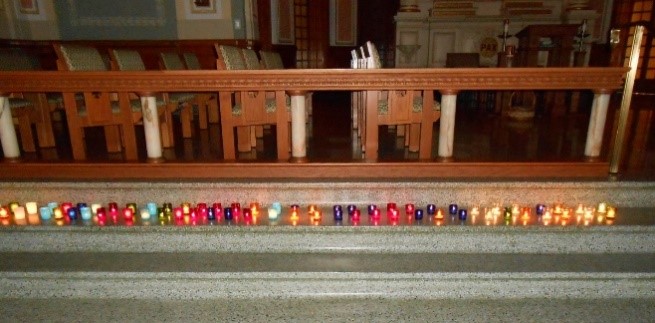 Our Ritual for All Souls Day
Our Ritual for All Souls Day
November 1, All Saints Day, is the day on which we honor all the holy people we probably have known throughout our lives, including our saintly Sisters in our Benedictine community. They have died and now live and see God in Heaven. We honor these holy souls who can intercede with God for our intentions and remember us with love as we remember them.
Here in our Monastery on the evening of November 1, we anticipate All Souls Day. In our anticipatory ritual of prayer for November 2, our Vesper service includes the lighting of a vigil light for each of our deceased Sisters as their name is mentioned in prayerful remembrance. This custom reminds us not only to pray for our deceased Sisters, but also for our deceased relatives and friends. As Catholics we believe in the Communion of Saints, which is the union of the saints in Heaven, the souls in Purgatory, and those of us here on Earth.
 Our Ritual for All Souls Day
Our Ritual for All Souls Day
November 1, All Saints Day, is the day on which we honor all the holy people we probably have known throughout our lives, including our saintly Sisters in our Benedictine community. They have died and now live and see God in Heaven. We honor these holy souls who can intercede with God for our intentions and remember us with love as we remember them.
Here in our Monastery on the evening of November 1, we anticipate All Souls Day. In our anticipatory ritual of prayer for November 2, our Vesper service includes the lighting of a vigil light for each of our deceased Sisters as their name is mentioned in prayerful remembrance. This custom reminds us not only to pray for our deceased Sisters, but also for our deceased relatives and friends. As Catholics we believe in the Communion of Saints, which is the union of the saints in Heaven, the souls in Purgatory, and those of us here on Earth.
Day 275: November 2, 2020
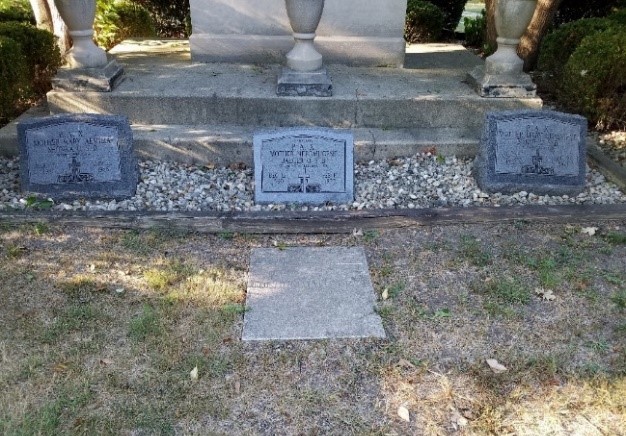
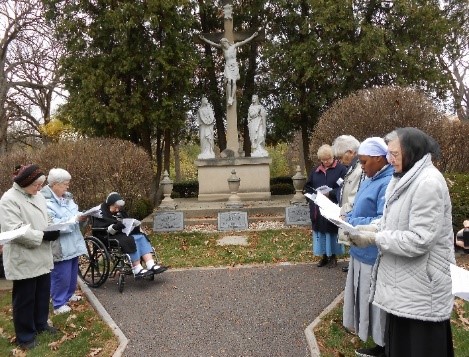 Our Earliest Prioresses Buried Below the Cross
Our Earliest Prioresses Buried Below the Cross
Mother Mary Nepomucene Jaeger, OSB, the first Prioress, Mother Genevieve Biskup, OSB, the second Prioress, and Mother Amelia Shonka, OSB, the third prioress, are buried here at the base of the crucifixion scene. They are honored for establishing the beginnings of our Benedictine community.
On November 2, our Sisters gather each year in our St. Scholastica Cemetery to pray for all our deceased Sisters, as well as our own relatives and friends. It is customary for us to remember our beloved deceased with grateful hearts and praise God for their exemplary lives as they continue to inspire us.

 Our Earliest Prioresses Buried Below the Cross
Our Earliest Prioresses Buried Below the Cross
Mother Mary Nepomucene Jaeger, OSB, the first Prioress, Mother Genevieve Biskup, OSB, the second Prioress, and Mother Amelia Shonka, OSB, the third prioress, are buried here at the base of the crucifixion scene. They are honored for establishing the beginnings of our Benedictine community.
On November 2, our Sisters gather each year in our St. Scholastica Cemetery to pray for all our deceased Sisters, as well as our own relatives and friends. It is customary for us to remember our beloved deceased with grateful hearts and praise God for their exemplary lives as they continue to inspire us.
Day 276: November 3, 2020
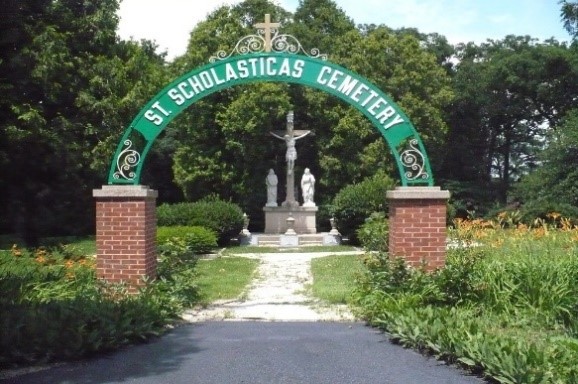 St. Scholastica Cemetery Entrance
St. Scholastica Cemetery Entrance
Saint Scholastica's Cemetery is located on the north side of Sacred Heart Monastery, and it is the final resting place for the Benedictine Sisters of Sacred Heart Monastery. A few years ago, our friends, Connie Julius and Larraine Matusak, donated money to restore the entry to the cemetery, namely, the brick columns and the archway sign as well as the pathway leading to the crucifixion scene. Recently, Nick Herrera and Sons built a grey-brick walkway around the back of the crucifixion scene leading to the burial area. How lovely and peaceful is this holy place embellished with the greenery of God’s lavish creation.
 St. Scholastica Cemetery Entrance
St. Scholastica Cemetery Entrance
Saint Scholastica's Cemetery is located on the north side of Sacred Heart Monastery, and it is the final resting place for the Benedictine Sisters of Sacred Heart Monastery. A few years ago, our friends, Connie Julius and Larraine Matusak, donated money to restore the entry to the cemetery, namely, the brick columns and the archway sign as well as the pathway leading to the crucifixion scene. Recently, Nick Herrera and Sons built a grey-brick walkway around the back of the crucifixion scene leading to the burial area. How lovely and peaceful is this holy place embellished with the greenery of God’s lavish creation.
Day 277: November 4, 2020
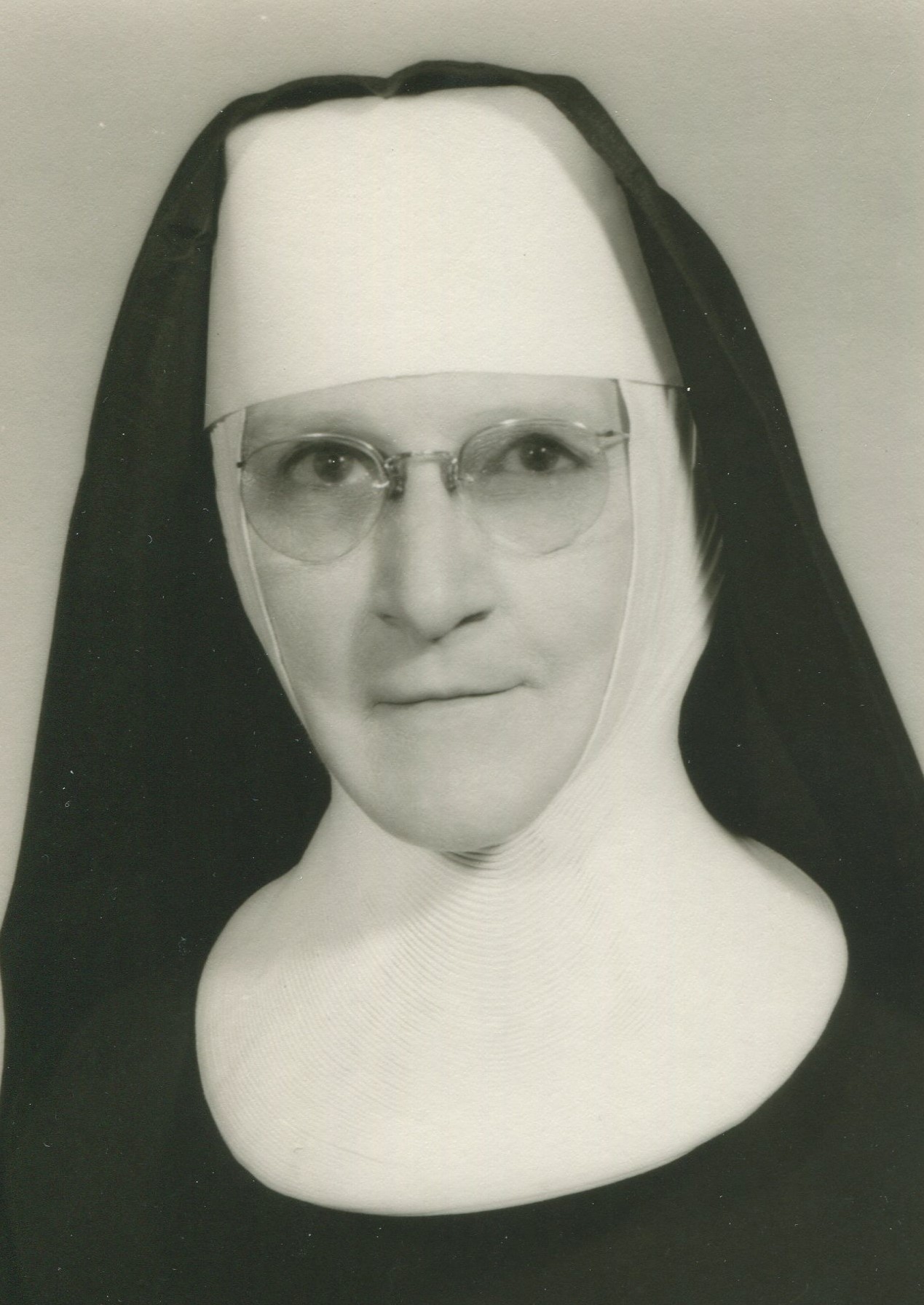 Janota, Sister Mary Delores (a.k.a. Sister Dolorosa) b. 9/22/1895 d. 11/4/1978 (Cousin of Sister Celine Laketak)
Janota, Sister Mary Delores (a.k.a. Sister Dolorosa) b. 9/22/1895 d. 11/4/1978 (Cousin of Sister Celine Laketak)
Sister Mary Delores was an exceptional science teacher, starting at the elementary level, then high school, and onto the college level. To many of the Academy students, she is still remembered for her stimulating biology and botany classes. Wanting the SHA Academy girls to be able to identify every tree and some plants on campus, she took the students on campus field trips for these visual studies. She made learning not only interesting, but also fun.
 Janota, Sister Mary Delores (a.k.a. Sister Dolorosa) b. 9/22/1895 d. 11/4/1978 (Cousin of Sister Celine Laketak)
Janota, Sister Mary Delores (a.k.a. Sister Dolorosa) b. 9/22/1895 d. 11/4/1978 (Cousin of Sister Celine Laketak)
Sister Mary Delores was an exceptional science teacher, starting at the elementary level, then high school, and onto the college level. To many of the Academy students, she is still remembered for her stimulating biology and botany classes. Wanting the SHA Academy girls to be able to identify every tree and some plants on campus, she took the students on campus field trips for these visual studies. She made learning not only interesting, but also fun.
Day 278: November 5, 2020
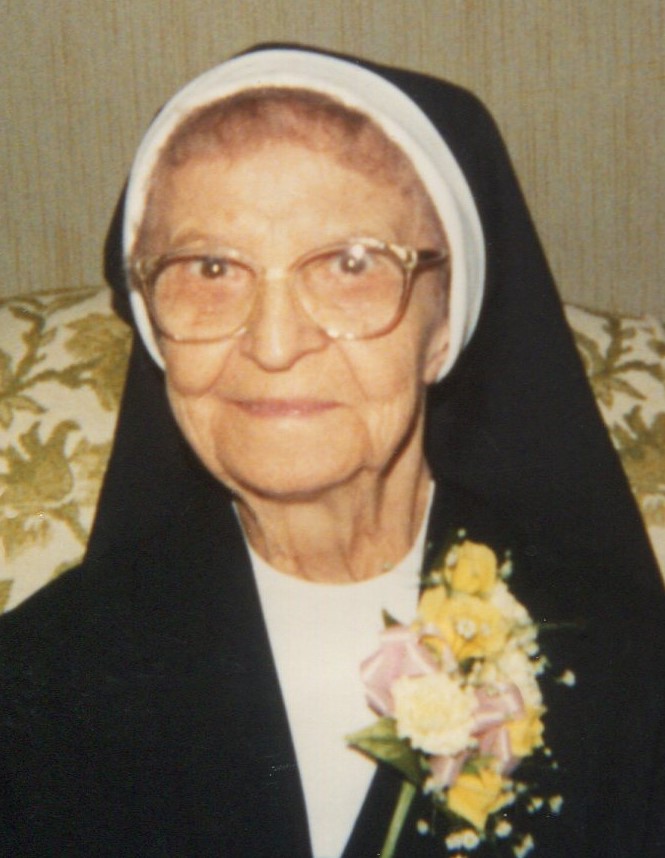 Harvanek, Sister Mary Raymond b. 5/3/1904 d. 11/4/1992 (Sister of Sisters Mary Agatha, Cecilia, Xaveria, and Innocencia)
Harvanek, Sister Mary Raymond b. 5/3/1904 d. 11/4/1992 (Sister of Sisters Mary Agatha, Cecilia, Xaveria, and Innocencia)
Sister Mary Raymond is remembered as having piercing brown eyes and being stern, but fair to her students. In school, she expected her students to be observant of her classroom rules and meant business with her piano students as well. Her prayer and work life were well ordered, as she had a set schedule for her private prayer as well as her assigned duties. Remembering her two sisters, Sisters Xaveria and Innocencia who died very young, she was most grateful to God for her 70 years of religious life.
 Harvanek, Sister Mary Raymond b. 5/3/1904 d. 11/4/1992 (Sister of Sisters Mary Agatha, Cecilia, Xaveria, and Innocencia)
Harvanek, Sister Mary Raymond b. 5/3/1904 d. 11/4/1992 (Sister of Sisters Mary Agatha, Cecilia, Xaveria, and Innocencia)
Sister Mary Raymond is remembered as having piercing brown eyes and being stern, but fair to her students. In school, she expected her students to be observant of her classroom rules and meant business with her piano students as well. Her prayer and work life were well ordered, as she had a set schedule for her private prayer as well as her assigned duties. Remembering her two sisters, Sisters Xaveria and Innocencia who died very young, she was most grateful to God for her 70 years of religious life.
Day 279: November 6, 2020
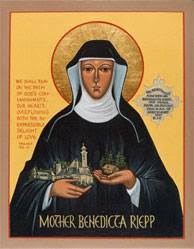 Mother Benedicta Riepp, OSB -Benedictine Foundress in the USA
Mother Benedicta Riepp, OSB -Benedictine Foundress in the USA
Mother Benedicta Riepp, OSB, was born on June 28, 1825. She made solemn vows on July 9, 1849, at St. Walburg Abbey in Eichstätt, Bavaria. In 1852, Abbot Boniface Wimmer, OSB, from Latrobe, PA, asked for Sisters from St. Walburg Abbey to come to St. Mary, PA, to teach immigrant German children. Three Sisters volunteered to go: Benedicta Riepp would be the superior, Walburga Dietrich, and Maura Flieger.
The Sisters set out from Eichstätt on June 12, 1852, arriving in New York on July 3. When they disembarked, they were surprised to find no welcome, even though Abbot Boniface had promised to meet them. Facing this challenge, they managed to make their way to Latrobe, arriving nineteen days later and surprising the monks at St. Vincent’s in Latrobe as they were not aware of their coming; Abbot Boniface had not made provisions for the Sisters. However from the start, the Sisters were clear about their two-fold mission in the United States: to instruct young girls and to spread the mission of the Benedictine Order in this new part of the world. This is exactly what they did. (Continued tomorrow.)
 Mother Benedicta Riepp, OSB -Benedictine Foundress in the USA
Mother Benedicta Riepp, OSB -Benedictine Foundress in the USA
Mother Benedicta Riepp, OSB, was born on June 28, 1825. She made solemn vows on July 9, 1849, at St. Walburg Abbey in Eichstätt, Bavaria. In 1852, Abbot Boniface Wimmer, OSB, from Latrobe, PA, asked for Sisters from St. Walburg Abbey to come to St. Mary, PA, to teach immigrant German children. Three Sisters volunteered to go: Benedicta Riepp would be the superior, Walburga Dietrich, and Maura Flieger.
The Sisters set out from Eichstätt on June 12, 1852, arriving in New York on July 3. When they disembarked, they were surprised to find no welcome, even though Abbot Boniface had promised to meet them. Facing this challenge, they managed to make their way to Latrobe, arriving nineteen days later and surprising the monks at St. Vincent’s in Latrobe as they were not aware of their coming; Abbot Boniface had not made provisions for the Sisters. However from the start, the Sisters were clear about their two-fold mission in the United States: to instruct young girls and to spread the mission of the Benedictine Order in this new part of the world. This is exactly what they did. (Continued tomorrow.)
Day 280: November 7, 2020
 Mother Riepp Benedicta Continued
Mother Riepp Benedicta Continued
By the fall of their arrival in 1852, the Sisters opened a small school, fulfilling a deep desire of the immigrant German community amidst extreme poverty and controversy. In desperation, Benedicta wrote to Archbishop Von Reisa in Bavaria, begging for $2500 for a convent. She described their convent being so small that, “as soon as one steps over the threshold of the doorway, one is already in the center of the house.” The need was for a place to receive young women who were interested in religious life, but she even had a greater concern and compassion for the immigrant community, especially the children. By January of 1853, she wrote to King Ludwig reporting that 60-80 girls were attending their school, but coming irregularly due to their long walk through the woods from their homes. “I am moved to pity for the dear little ones coming half-dressed and numb from the cold and then have nothing to eat all day except a piece of black bread.” Some of these girls were taken in by the Sisters and raised as orphans.
Mother Benedicta Riepp’s heroic life story continues, as we wonder how she could have remained so tenacious in her drive to succeed under such incredible conditions of extreme poverty and contention with Abbot Boniface, who wanted to make all the decisions for the Sisters as well as misdirecting their funds. Additionally, there was the influx of young women who chose religious life for whom there was very little space. (Continued on November 11.)
 Mother Riepp Benedicta Continued
Mother Riepp Benedicta Continued
By the fall of their arrival in 1852, the Sisters opened a small school, fulfilling a deep desire of the immigrant German community amidst extreme poverty and controversy. In desperation, Benedicta wrote to Archbishop Von Reisa in Bavaria, begging for $2500 for a convent. She described their convent being so small that, “as soon as one steps over the threshold of the doorway, one is already in the center of the house.” The need was for a place to receive young women who were interested in religious life, but she even had a greater concern and compassion for the immigrant community, especially the children. By January of 1853, she wrote to King Ludwig reporting that 60-80 girls were attending their school, but coming irregularly due to their long walk through the woods from their homes. “I am moved to pity for the dear little ones coming half-dressed and numb from the cold and then have nothing to eat all day except a piece of black bread.” Some of these girls were taken in by the Sisters and raised as orphans.
Mother Benedicta Riepp’s heroic life story continues, as we wonder how she could have remained so tenacious in her drive to succeed under such incredible conditions of extreme poverty and contention with Abbot Boniface, who wanted to make all the decisions for the Sisters as well as misdirecting their funds. Additionally, there was the influx of young women who chose religious life for whom there was very little space. (Continued on November 11.)
Day 281: November 8, 2020
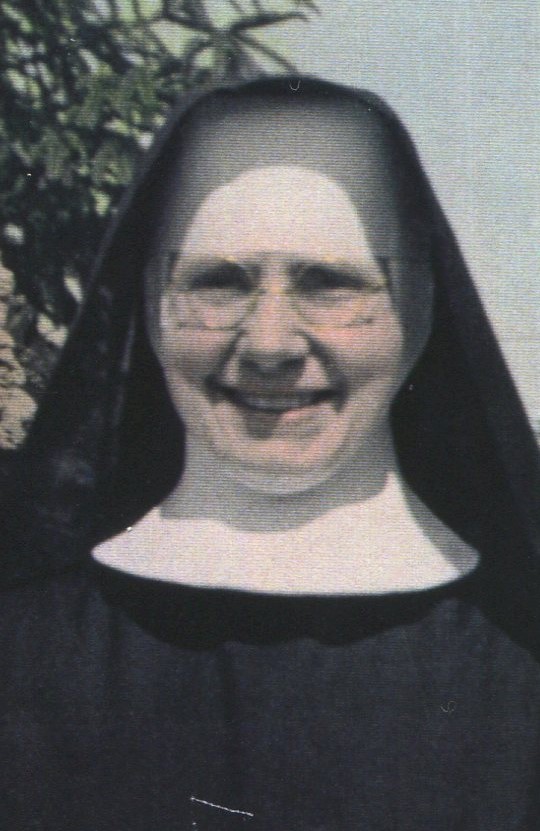 Bratrsovsky, Sister Mary Annunciata b. 1/25/1909 d. 11/8/1981 (Sister of Sisters Immaculate, and Alma. Niece of Sister Mary Coletta, Cousin of Sister Marie Bartek and Aunt of Sister Mary Bratrsovsky)
Bratrsovsky, Sister Mary Annunciata b. 1/25/1909 d. 11/8/1981 (Sister of Sisters Immaculate, and Alma. Niece of Sister Mary Coletta, Cousin of Sister Marie Bartek and Aunt of Sister Mary Bratrsovsky)
Sister Mary Annunciata had a cordial, gentle, witty disposition even though she suffered from childhood polio. Learning how to sew from her mother, she became a professional seamstress here in the Monastery, sewing our traditional habits and other items of importance. When her mother was in need of hospice care, Sister Mary Annunciata went back to Denver to take care of her until she died the following year. For a number of years, Sister Mary Annunciata played the organ to accompany the Sisters’ chanting the Divine Office. Never complaining about her poor health, she proved to be a most valuable Benedictine in her loving, willing way.
 Bratrsovsky, Sister Mary Annunciata b. 1/25/1909 d. 11/8/1981 (Sister of Sisters Immaculate, and Alma. Niece of Sister Mary Coletta, Cousin of Sister Marie Bartek and Aunt of Sister Mary Bratrsovsky)
Bratrsovsky, Sister Mary Annunciata b. 1/25/1909 d. 11/8/1981 (Sister of Sisters Immaculate, and Alma. Niece of Sister Mary Coletta, Cousin of Sister Marie Bartek and Aunt of Sister Mary Bratrsovsky)
Sister Mary Annunciata had a cordial, gentle, witty disposition even though she suffered from childhood polio. Learning how to sew from her mother, she became a professional seamstress here in the Monastery, sewing our traditional habits and other items of importance. When her mother was in need of hospice care, Sister Mary Annunciata went back to Denver to take care of her until she died the following year. For a number of years, Sister Mary Annunciata played the organ to accompany the Sisters’ chanting the Divine Office. Never complaining about her poor health, she proved to be a most valuable Benedictine in her loving, willing way.
Day 282: November 9, 2020
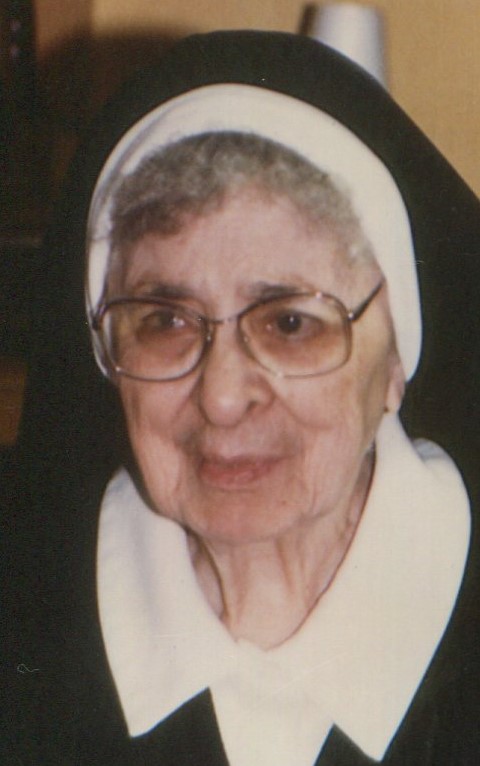 Brazda, Sister Mary Bernard b. 3/18/1903 d. 11/8/1981
Brazda, Sister Mary Bernard b. 3/18/1903 d. 11/8/1981
Sister Mary Bernard’s father died before she was born and with her mother’s second marriage, her stepfather disciplined her to play the piano and organ. At age 5, she sat at the organ in her parish church to play and praise the Lord, while her brothers pumped the pedals as she could not reach them. Coming from Omaha to Lisle at age 15, she was immediately able to gift the community and the future parishes, where she would teach with her musical talent as well as with her beholden personality for the next 80 years in religious life. In her later years, she became blind but remained valiant as she sat in darkness exuding the light of her generosity. With her dresser drawer full of chocolates to serve her many visitors, she was able as well to favor her sweet tooth at ready service.
 Brazda, Sister Mary Bernard b. 3/18/1903 d. 11/8/1981
Brazda, Sister Mary Bernard b. 3/18/1903 d. 11/8/1981
Sister Mary Bernard’s father died before she was born and with her mother’s second marriage, her stepfather disciplined her to play the piano and organ. At age 5, she sat at the organ in her parish church to play and praise the Lord, while her brothers pumped the pedals as she could not reach them. Coming from Omaha to Lisle at age 15, she was immediately able to gift the community and the future parishes, where she would teach with her musical talent as well as with her beholden personality for the next 80 years in religious life. In her later years, she became blind but remained valiant as she sat in darkness exuding the light of her generosity. With her dresser drawer full of chocolates to serve her many visitors, she was able as well to favor her sweet tooth at ready service.
Day 283: November 10, 2020
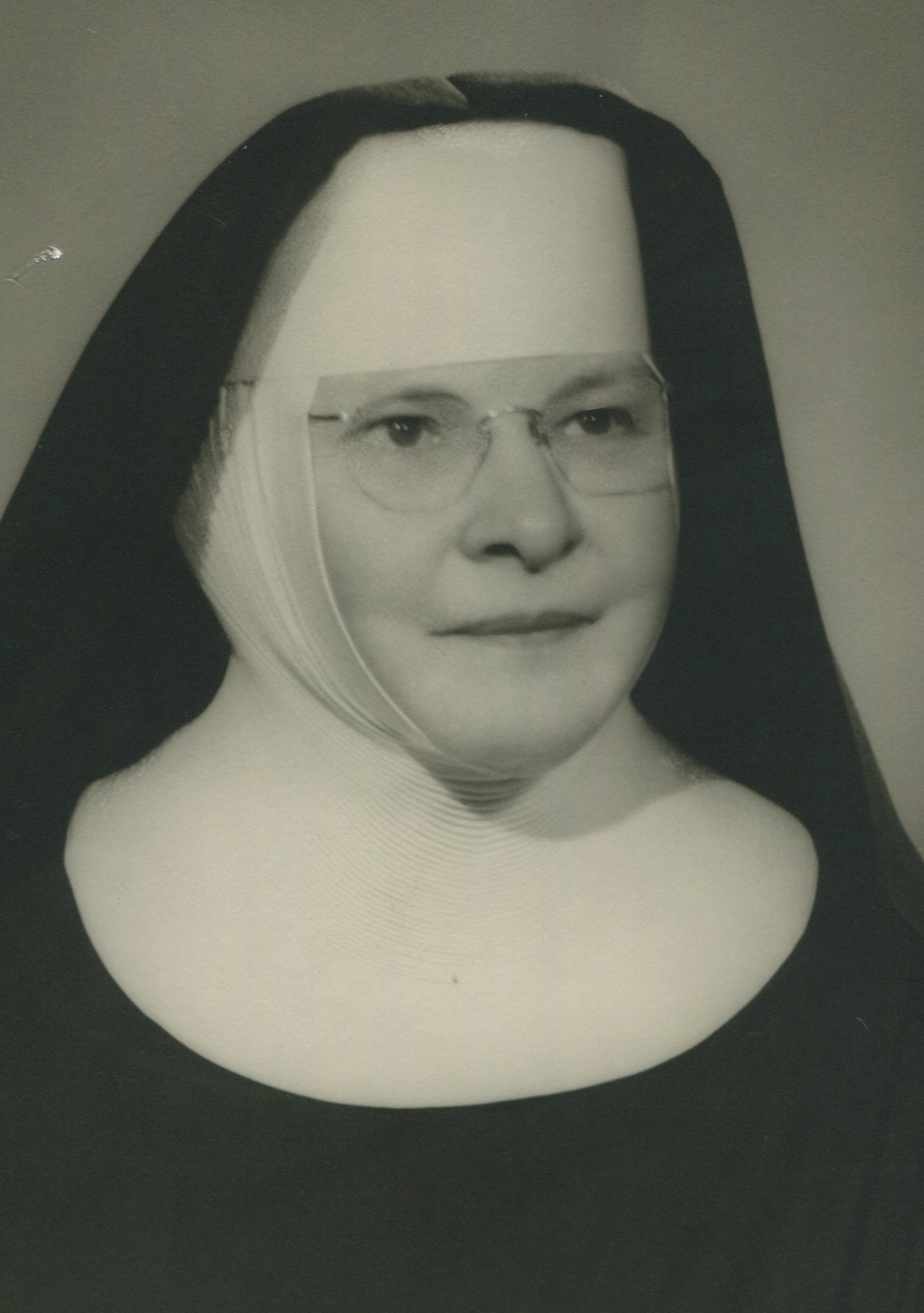 Kral, Sister Mary Clara b. 10/30/1883 d. 11/10/1966
Kral, Sister Mary Clara b. 10/30/1883 d. 11/10/1966
Sister Mary Clara was a regal woman positioned to teach and take the leadership role of principal. Most of her years were spent at Our Lady of the Mount in Cicero, Illinois. She loved the Sisters and the students in the school, being ever ready to give advice with her thoughtful wisdom gleaned over the years. With her talented fingers, she crocheted beautiful items as gifts or for valued prizes at church festivals. Her life was cheerful and grateful for her 65 years of Benedictine life.
 Kral, Sister Mary Clara b. 10/30/1883 d. 11/10/1966
Kral, Sister Mary Clara b. 10/30/1883 d. 11/10/1966
Sister Mary Clara was a regal woman positioned to teach and take the leadership role of principal. Most of her years were spent at Our Lady of the Mount in Cicero, Illinois. She loved the Sisters and the students in the school, being ever ready to give advice with her thoughtful wisdom gleaned over the years. With her talented fingers, she crocheted beautiful items as gifts or for valued prizes at church festivals. Her life was cheerful and grateful for her 65 years of Benedictine life.
Day 284: November 11, 2020
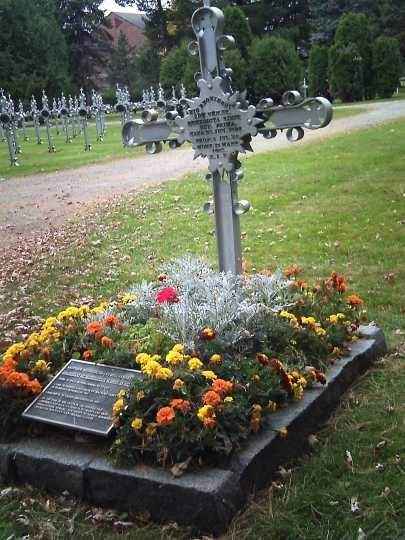 Mother Riepp Benedicta Continued
Mother Riepp Benedicta Continued
Mother Benedicta Riepp died of tuberculosis at St. Cloud, MN, on March 15, 1862, at age 36. She is buried at St. Benedict Monastery in St. Joseph, MN. At the time of her death after only ten years in the U.S., six independent communities of Benedictine women were established and were thriving: St. Mary, PA (1852); Erie, PA (1856); Newark, N.J. (1857); St. Cloud, MN (1857); Covington, KY (1859); and Chicago, IL (1861). Gratefully, Benedicta Riepp’s mission to instruct young girls and to spread the Benedictine Order in this part of the world was realized. She once had a dream about a tree that had many blossoms, which consoled her during her difficult times in her short life. Today we see Benedicta’s dream was also prophetic as the tree of the Benedictine Order was beginning to blossom and its roots were expanding. Our monastery here in Lisle was founded in 1895 from St. Mary, PA. May God be praised for Mother Benedicta Riepp, OSB!
 Mother Riepp Benedicta Continued
Mother Riepp Benedicta Continued
Mother Benedicta Riepp died of tuberculosis at St. Cloud, MN, on March 15, 1862, at age 36. She is buried at St. Benedict Monastery in St. Joseph, MN. At the time of her death after only ten years in the U.S., six independent communities of Benedictine women were established and were thriving: St. Mary, PA (1852); Erie, PA (1856); Newark, N.J. (1857); St. Cloud, MN (1857); Covington, KY (1859); and Chicago, IL (1861). Gratefully, Benedicta Riepp’s mission to instruct young girls and to spread the Benedictine Order in this part of the world was realized. She once had a dream about a tree that had many blossoms, which consoled her during her difficult times in her short life. Today we see Benedicta’s dream was also prophetic as the tree of the Benedictine Order was beginning to blossom and its roots were expanding. Our monastery here in Lisle was founded in 1895 from St. Mary, PA. May God be praised for Mother Benedicta Riepp, OSB!
Day 285: November 12, 2020
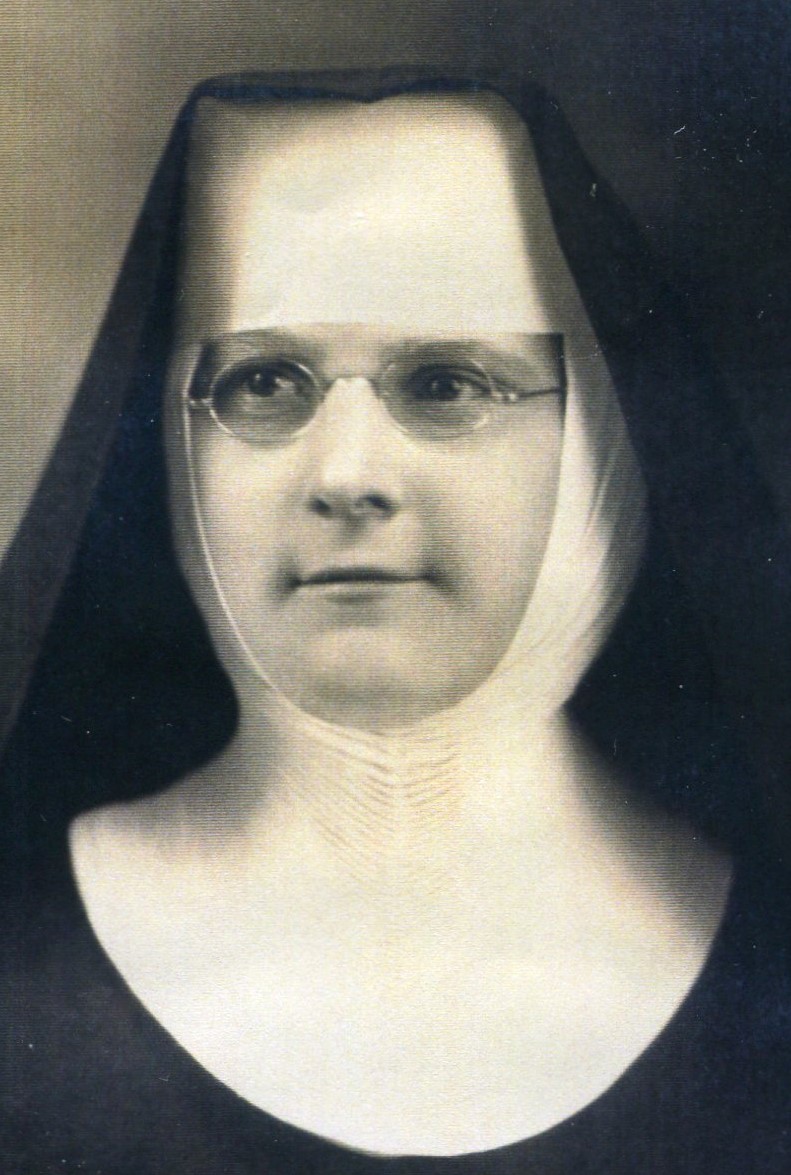 Tichota, Sister Mary Marcella b. 3/10/1887 d. 11/12/1939
Tichota, Sister Mary Marcella b. 3/10/1887 d. 11/12/1939
Sister Mary Marcella was among the pioneer Sisters who accepted, with faith in God, the challenges of the poverty of those early days. Talented not only in teaching, she was also very artistic and was asked to help the Sisters who were teaching to decorate their classrooms. She took art and business lessons from the B.V.M. Sisters at St Pius School, who lived a few blocks from St. Vitus. She always gave a hand at the St. Vitus parish entertainments and was someone to go to if help was needed.
 Tichota, Sister Mary Marcella b. 3/10/1887 d. 11/12/1939
Tichota, Sister Mary Marcella b. 3/10/1887 d. 11/12/1939
Sister Mary Marcella was among the pioneer Sisters who accepted, with faith in God, the challenges of the poverty of those early days. Talented not only in teaching, she was also very artistic and was asked to help the Sisters who were teaching to decorate their classrooms. She took art and business lessons from the B.V.M. Sisters at St Pius School, who lived a few blocks from St. Vitus. She always gave a hand at the St. Vitus parish entertainments and was someone to go to if help was needed.
Day 286: November 13, 2020
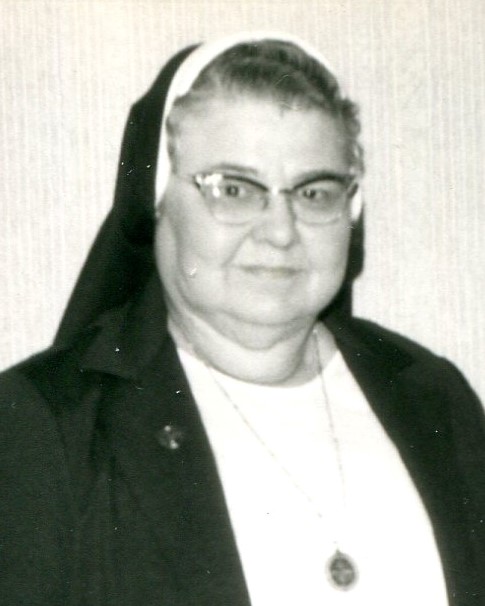 Bartek, Sister Marie (Sister Colettine) b. 6/21/1914 d. 11/14/1981 (Niece of Sister Coletta, Cousin of Sisters Immaculate, Alma and Annunciata)
Bartek, Sister Marie (Sister Colettine) b. 6/21/1914 d. 11/14/1981 (Niece of Sister Coletta, Cousin of Sisters Immaculate, Alma and Annunciata)
Sister Marie was always jovial and had a reputation to be a gracious receptionist, extending her warm welcome to all guests as St. Benedict advises us to do. Most of her ministry years were spent in elementary school at the junior high level. She showed a great interest in her students by keeping in touch with some of them over the years. In her later years, she taught fine arts at Benet Academy. In the Monastery, she was able to showcase her artwork displaying her God given talent.
 Bartek, Sister Marie (Sister Colettine) b. 6/21/1914 d. 11/14/1981 (Niece of Sister Coletta, Cousin of Sisters Immaculate, Alma and Annunciata)
Bartek, Sister Marie (Sister Colettine) b. 6/21/1914 d. 11/14/1981 (Niece of Sister Coletta, Cousin of Sisters Immaculate, Alma and Annunciata)
Sister Marie was always jovial and had a reputation to be a gracious receptionist, extending her warm welcome to all guests as St. Benedict advises us to do. Most of her ministry years were spent in elementary school at the junior high level. She showed a great interest in her students by keeping in touch with some of them over the years. In her later years, she taught fine arts at Benet Academy. In the Monastery, she was able to showcase her artwork displaying her God given talent.
Day 287: November 14, 2020
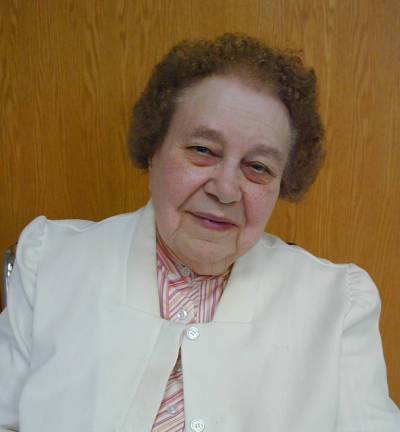 Vesely, Sister Mary Charlotte b. 5/22/1918 d. 11/14/2008 (Fifth Prioress: 1973-1985)
Vesely, Sister Mary Charlotte b. 5/22/1918 d. 11/14/2008 (Fifth Prioress: 1973-1985)
Sister Mary Charlotte was a graduate of Sacred Heart Academy. Upon entering the Monastery, she became a dynamic presence in our community. Her “Kate Smith’s” contralto voice was not only beautiful, but was also the energy that supported our Benedictine Sisters’ chapel choir as long as she lived. Being a happy, friendly person, she won the hearts of everyone who got to know her. As a Sacred Heart Academy English and music teacher and class advisor, as well as when she taught or was principal in our parish schools, she was dearly loved. When elected the fifth prioress of Sacred Heart Monastery, she initiated the renovation of the former Sacred Heart Academy building, which had already been vacated in 1967 due to the merge that formed Benet Academy. It was then, in 1977, that the Academy building was duly refurbished to become the new modernized version of Sacred Heart Monastery. Our grateful community owes Sister Mary Charlotte many thanks!
 Vesely, Sister Mary Charlotte b. 5/22/1918 d. 11/14/2008 (Fifth Prioress: 1973-1985)
Vesely, Sister Mary Charlotte b. 5/22/1918 d. 11/14/2008 (Fifth Prioress: 1973-1985)
Sister Mary Charlotte was a graduate of Sacred Heart Academy. Upon entering the Monastery, she became a dynamic presence in our community. Her “Kate Smith’s” contralto voice was not only beautiful, but was also the energy that supported our Benedictine Sisters’ chapel choir as long as she lived. Being a happy, friendly person, she won the hearts of everyone who got to know her. As a Sacred Heart Academy English and music teacher and class advisor, as well as when she taught or was principal in our parish schools, she was dearly loved. When elected the fifth prioress of Sacred Heart Monastery, she initiated the renovation of the former Sacred Heart Academy building, which had already been vacated in 1967 due to the merge that formed Benet Academy. It was then, in 1977, that the Academy building was duly refurbished to become the new modernized version of Sacred Heart Monastery. Our grateful community owes Sister Mary Charlotte many thanks!
Day 288: November 15, 2020
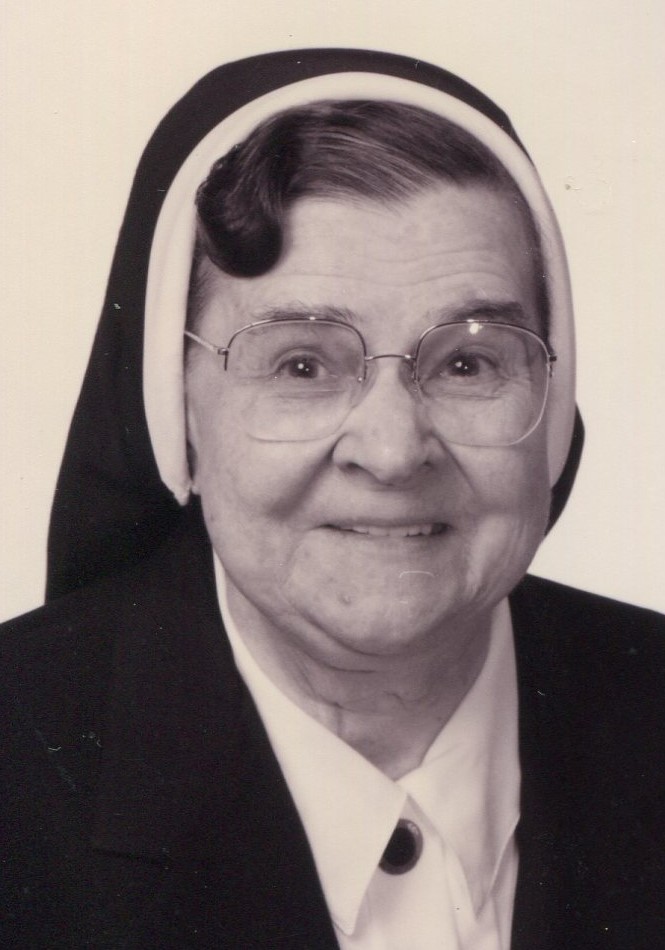 Naudzius, Sister Mary Gertrude b. 11/27/1916 d. 11/15/2004
Naudzius, Sister Mary Gertrude b. 11/27/1916 d. 11/15/2004
Sister Mary Gertrude lost her mother at age 6. Being obliged to work, her father was unable to take care of his three children and chose to place them under the care of the Benedictine Sisters at St. Joseph’s Orphanage in Lisle. Sister’s life was happy there, and she gradually developed into a responsible teenager with the Benedictine Sisters as her mentors. She admired the Sisters and decided to follow their footsteps, entering Sacred Heart Monastery at age 19. Given the name of Gertrude in the Monastery, she read the life of St. Gertrude of Helfta, a 14th century Benedictine who became her model for the rest of her life. Throughout her life in ministry, as she conscientiously taught children or as she cleaned the monastery building, which was a monumental job, she was in awe of God’s loving presence. Her prayer life went beyond the daily community chanting of the Divine Office. She prayed the fifteen decades of the Rosary as an added conversation with Mary and her Son, Jesus. Her saintly joyful life was an inspiration to us all, and we are grateful for having had her presence among us.
 Naudzius, Sister Mary Gertrude b. 11/27/1916 d. 11/15/2004
Naudzius, Sister Mary Gertrude b. 11/27/1916 d. 11/15/2004
Sister Mary Gertrude lost her mother at age 6. Being obliged to work, her father was unable to take care of his three children and chose to place them under the care of the Benedictine Sisters at St. Joseph’s Orphanage in Lisle. Sister’s life was happy there, and she gradually developed into a responsible teenager with the Benedictine Sisters as her mentors. She admired the Sisters and decided to follow their footsteps, entering Sacred Heart Monastery at age 19. Given the name of Gertrude in the Monastery, she read the life of St. Gertrude of Helfta, a 14th century Benedictine who became her model for the rest of her life. Throughout her life in ministry, as she conscientiously taught children or as she cleaned the monastery building, which was a monumental job, she was in awe of God’s loving presence. Her prayer life went beyond the daily community chanting of the Divine Office. She prayed the fifteen decades of the Rosary as an added conversation with Mary and her Son, Jesus. Her saintly joyful life was an inspiration to us all, and we are grateful for having had her presence among us.
Day 289: November 16, 2020
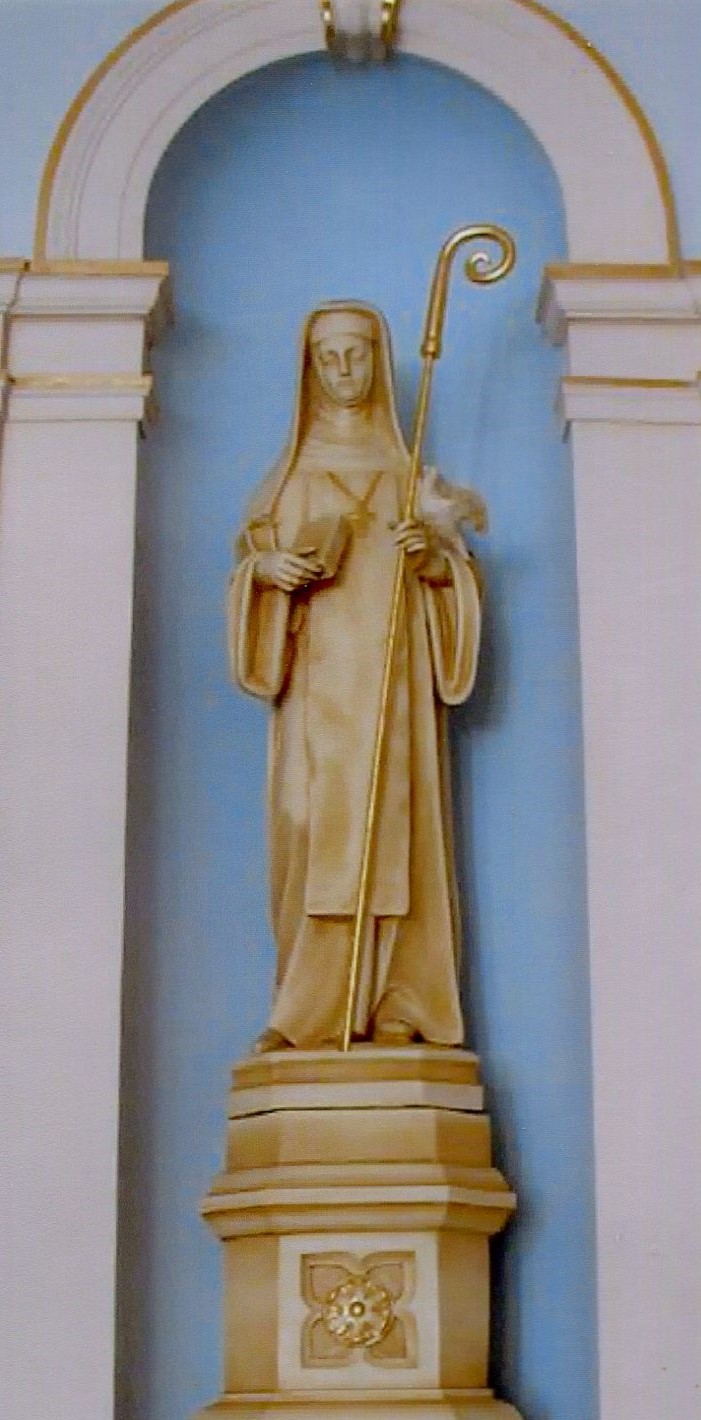 Lobby Statue-St. Scholastica
Lobby Statue-St. Scholastica
St. Scholastic was born in 480 in Italy. Being the twin Sister of St. Benedict, she joined him in founding Benedictine Women Monastics, who later spread throughout the world. A statue of St. Scholastica is seen on the right side at the top of the staircase in the Benedale lobby. St. Scholastica lived a saintly life, observing the Rule her brother wrote. She was blest to start Monasteries for women in Italy and in the rest of Europe. She is as well honored for her great love of God. We remember the miracle that happened with the last visit she was having with her brother who refused to stay overnight. She then put her head down to pray, for she felt their conversation about heaven was important. God heard her prayer immediately, sending a storm with flashes of lightening and loud bursts of thunder. What else could Benedict do but stay?
 Lobby Statue-St. Scholastica
Lobby Statue-St. Scholastica
St. Scholastic was born in 480 in Italy. Being the twin Sister of St. Benedict, she joined him in founding Benedictine Women Monastics, who later spread throughout the world. A statue of St. Scholastica is seen on the right side at the top of the staircase in the Benedale lobby. St. Scholastica lived a saintly life, observing the Rule her brother wrote. She was blest to start Monasteries for women in Italy and in the rest of Europe. She is as well honored for her great love of God. We remember the miracle that happened with the last visit she was having with her brother who refused to stay overnight. She then put her head down to pray, for she felt their conversation about heaven was important. God heard her prayer immediately, sending a storm with flashes of lightening and loud bursts of thunder. What else could Benedict do but stay?
Day 290: November 17, 2020
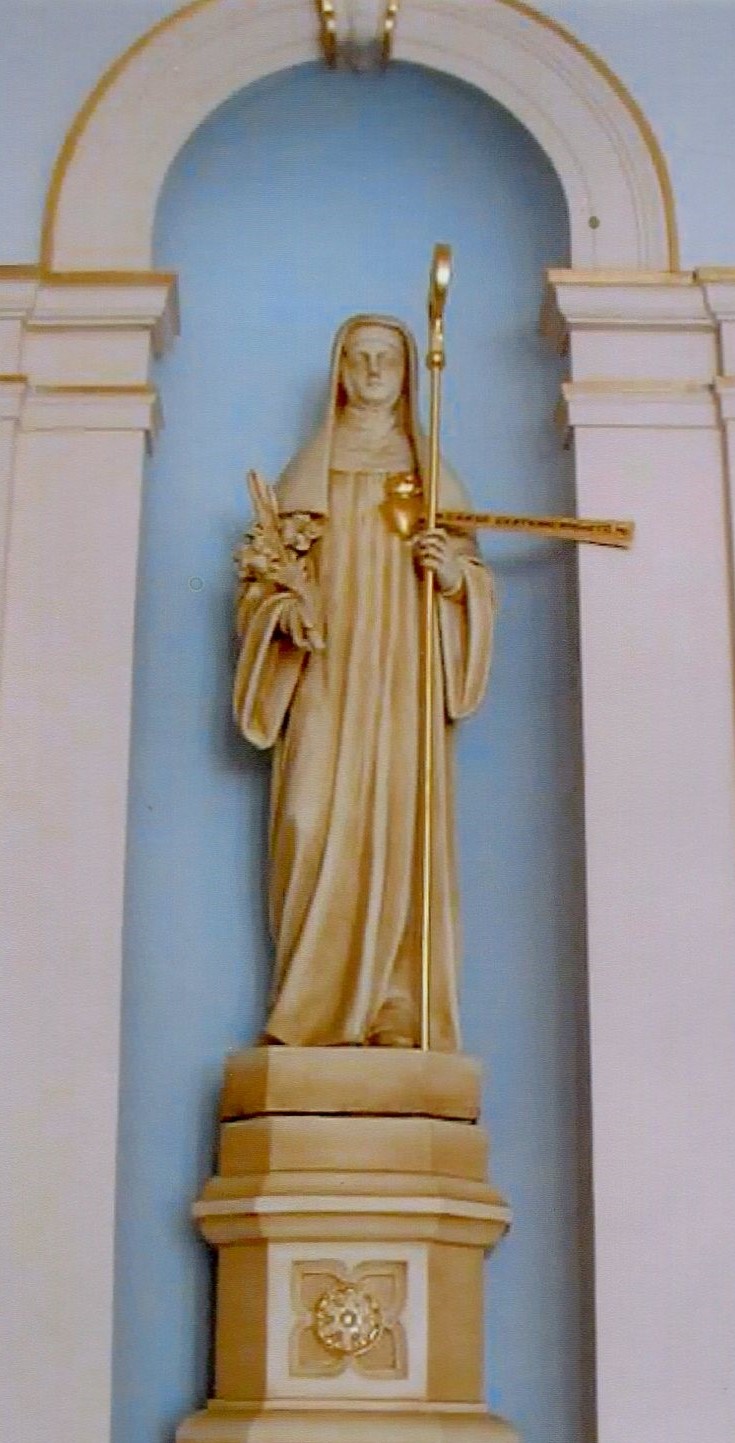 Lobby Statue-St. Gertrude the Great (1256-1301)
Lobby Statue-St. Gertrude the Great (1256-1301)
St Gertrude the Great is a German Benedictine saint, mystic, and theologian whose feast day for the Benedictines is November 17. A statue of St. Gertrude is seen at the top of the stairs on the left side in the Benedale lobby. An arrow pointing to her heart is symbolic of the devotion she had to the Sacred Heart of Jesus. In her history we read that in 1281 at the age of 25, she experienced the first of a series of visions of the Sacred Heart of Jesus, which continued for the rest of her life. These visions gave her the inspiration to write about her devotion and “The Herald of Divine Love” is one of her most well-known manuscripts. It is from St. Gertrude’s devotion to the Sacred Heart of Jesus that our early Sisters wanted us to continue our love for the Sacred Heart of Jesus, and that is the reason why our Monastery was named for the Sacred Heart (of Jesus).
 Lobby Statue-St. Gertrude the Great (1256-1301)
Lobby Statue-St. Gertrude the Great (1256-1301)
St Gertrude the Great is a German Benedictine saint, mystic, and theologian whose feast day for the Benedictines is November 17. A statue of St. Gertrude is seen at the top of the stairs on the left side in the Benedale lobby. An arrow pointing to her heart is symbolic of the devotion she had to the Sacred Heart of Jesus. In her history we read that in 1281 at the age of 25, she experienced the first of a series of visions of the Sacred Heart of Jesus, which continued for the rest of her life. These visions gave her the inspiration to write about her devotion and “The Herald of Divine Love” is one of her most well-known manuscripts. It is from St. Gertrude’s devotion to the Sacred Heart of Jesus that our early Sisters wanted us to continue our love for the Sacred Heart of Jesus, and that is the reason why our Monastery was named for the Sacred Heart (of Jesus).
Day 291: November 18, 2020
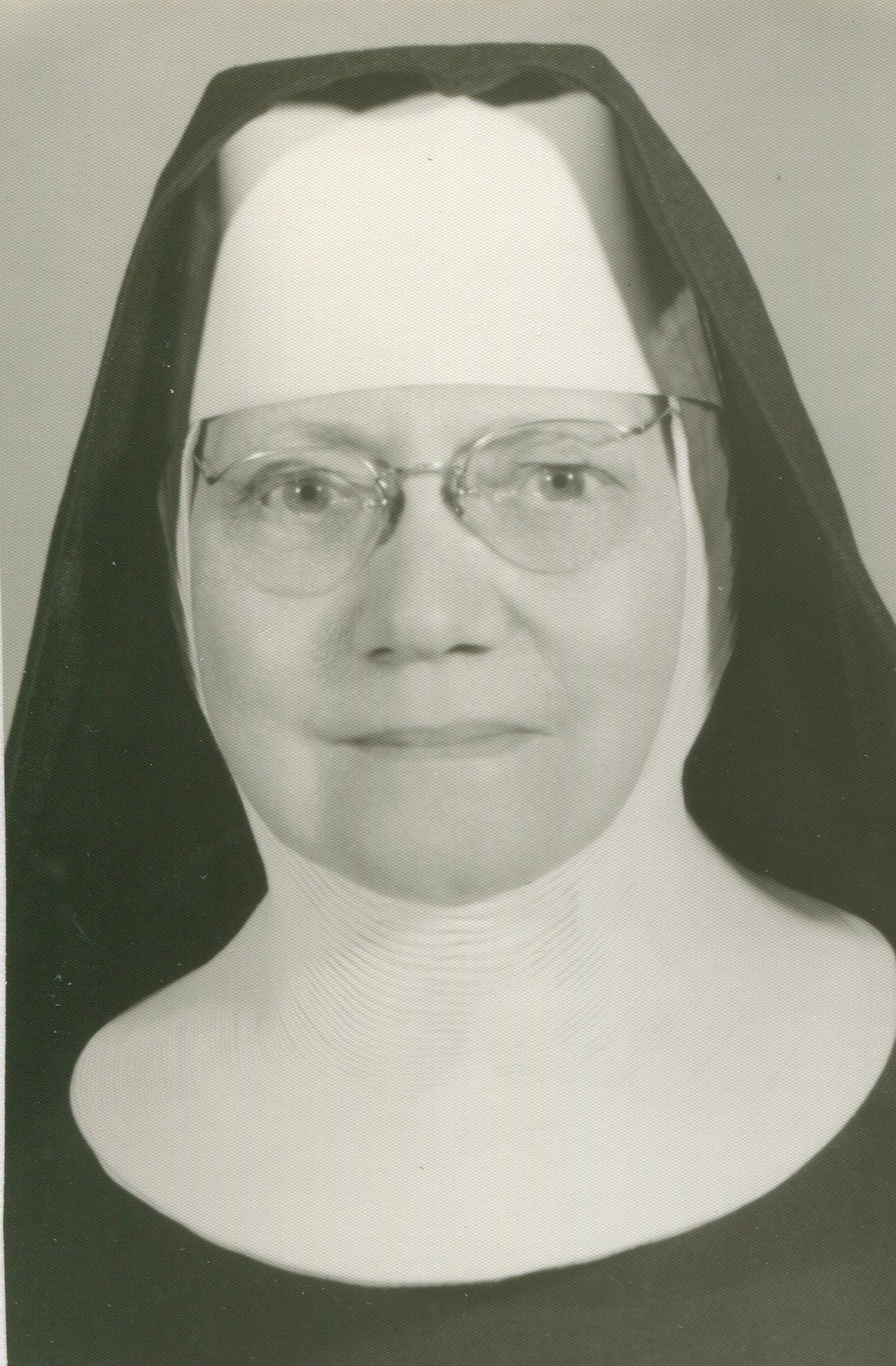 Spinler, Sister Mary Wendeline b. 5/26/1892 d. 11/18/1978 (Oldest Sister of Sisters Adela, Rose Alice, Milburg and Bertha)
Spinler, Sister Mary Wendeline b. 5/26/1892 d. 11/18/1978 (Oldest Sister of Sisters Adela, Rose Alice, Milburg and Bertha)
Sister Mary Wendeline came from a large Minnesota, farm family. As a Benedictine, she lived a humble, productive life usually cooking for the Sisters who were teaching in parish schools. She appreciated having been a farm girl and relished the beauty of nature and the outdoors. When the mallard ducklings were hatched on our rock pond island on our monastery grounds, already in her golden years, she would watch over them and feed them with scraps of food from the table. Once as she was taking a walk on the road in the back of the kitchen, the ducklings were seen following her as if she was their mother. What a precious sight it was even though she did not know they were behind her.
 Spinler, Sister Mary Wendeline b. 5/26/1892 d. 11/18/1978 (Oldest Sister of Sisters Adela, Rose Alice, Milburg and Bertha)
Spinler, Sister Mary Wendeline b. 5/26/1892 d. 11/18/1978 (Oldest Sister of Sisters Adela, Rose Alice, Milburg and Bertha)
Sister Mary Wendeline came from a large Minnesota, farm family. As a Benedictine, she lived a humble, productive life usually cooking for the Sisters who were teaching in parish schools. She appreciated having been a farm girl and relished the beauty of nature and the outdoors. When the mallard ducklings were hatched on our rock pond island on our monastery grounds, already in her golden years, she would watch over them and feed them with scraps of food from the table. Once as she was taking a walk on the road in the back of the kitchen, the ducklings were seen following her as if she was their mother. What a precious sight it was even though she did not know they were behind her.
Day 292: November 19, 2020
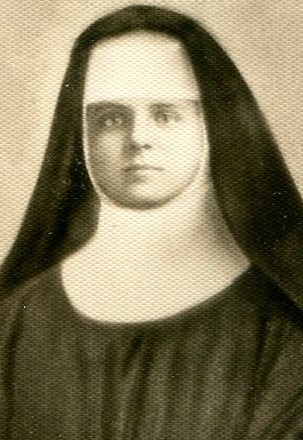 Cerveny, Sister Mary Angela b. 9/21/1893 d. 11/19/1928
Cerveny, Sister Mary Angela b. 9/21/1893 d. 11/19/1928
Rose Cerveny, (later given the religious name, Sister Mary Angela) came to the monastery as a little, 13 year-old, orphan girl. She looked sweet, seldom spoke but her smile made her face light up so the Sisters nick-named her Rosebud. She was eager to make vows but due to her young age she had to wait. When she told the spiritual director about her desire to make vows, he replied, “Yes, my dear, the Lord Jesus would want you to make vows, but the Lord Bishop would kick about it.” As she matured and made vows, she was given charge of the kitchen. She proved to be a good cook, was orderly, exact and virtuous. She liked to surprise the dishwashers by cleaning up after her food preparation leaving only a few pots or spoons for them to finish washing. However, in her 33rd year, she was diagnosed with T.B. and died a tranquil death ready to meet her loving Savior.
 Cerveny, Sister Mary Angela b. 9/21/1893 d. 11/19/1928
Cerveny, Sister Mary Angela b. 9/21/1893 d. 11/19/1928
Rose Cerveny, (later given the religious name, Sister Mary Angela) came to the monastery as a little, 13 year-old, orphan girl. She looked sweet, seldom spoke but her smile made her face light up so the Sisters nick-named her Rosebud. She was eager to make vows but due to her young age she had to wait. When she told the spiritual director about her desire to make vows, he replied, “Yes, my dear, the Lord Jesus would want you to make vows, but the Lord Bishop would kick about it.” As she matured and made vows, she was given charge of the kitchen. She proved to be a good cook, was orderly, exact and virtuous. She liked to surprise the dishwashers by cleaning up after her food preparation leaving only a few pots or spoons for them to finish washing. However, in her 33rd year, she was diagnosed with T.B. and died a tranquil death ready to meet her loving Savior.
Day 293: November 20, 2020
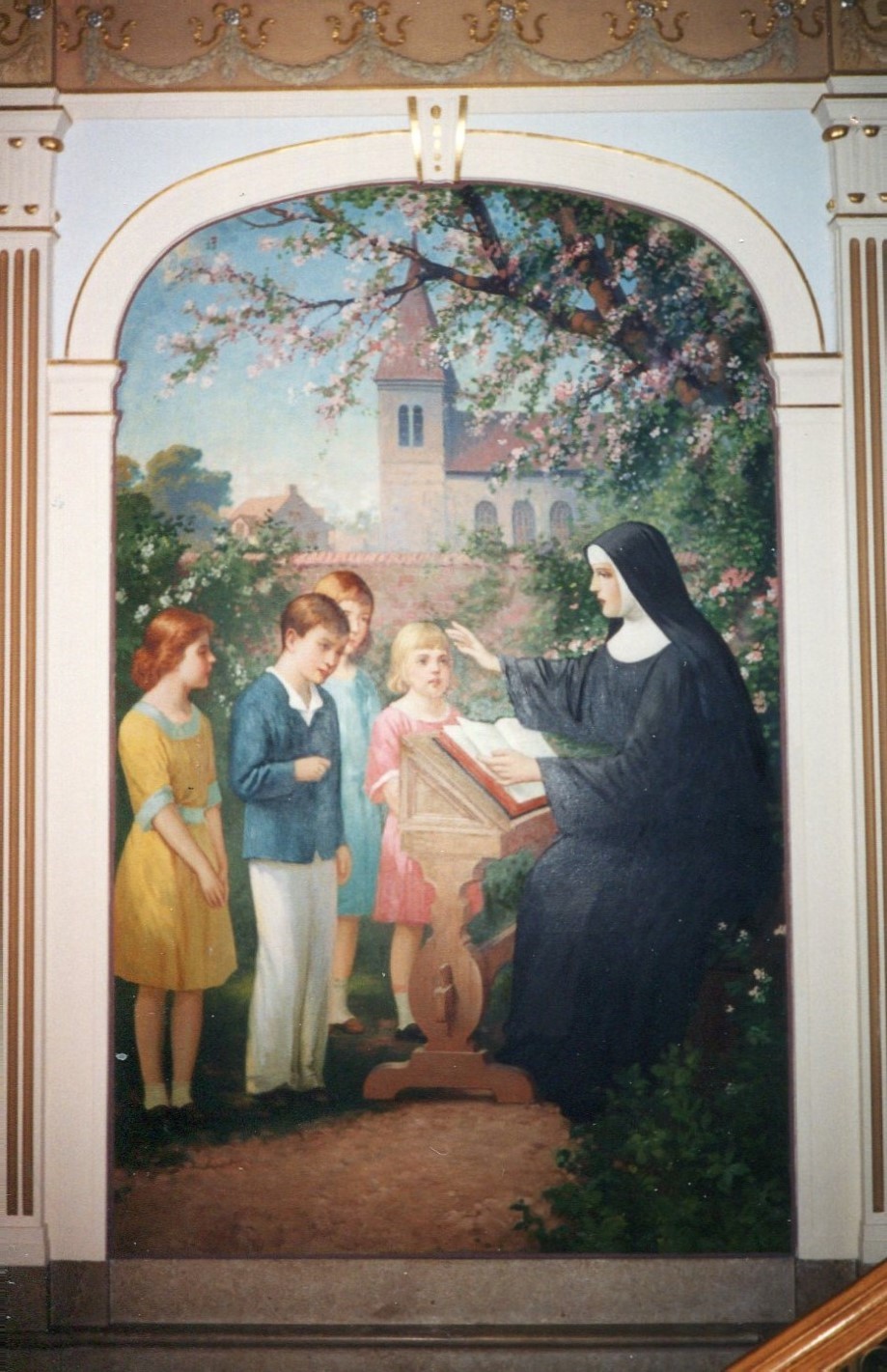
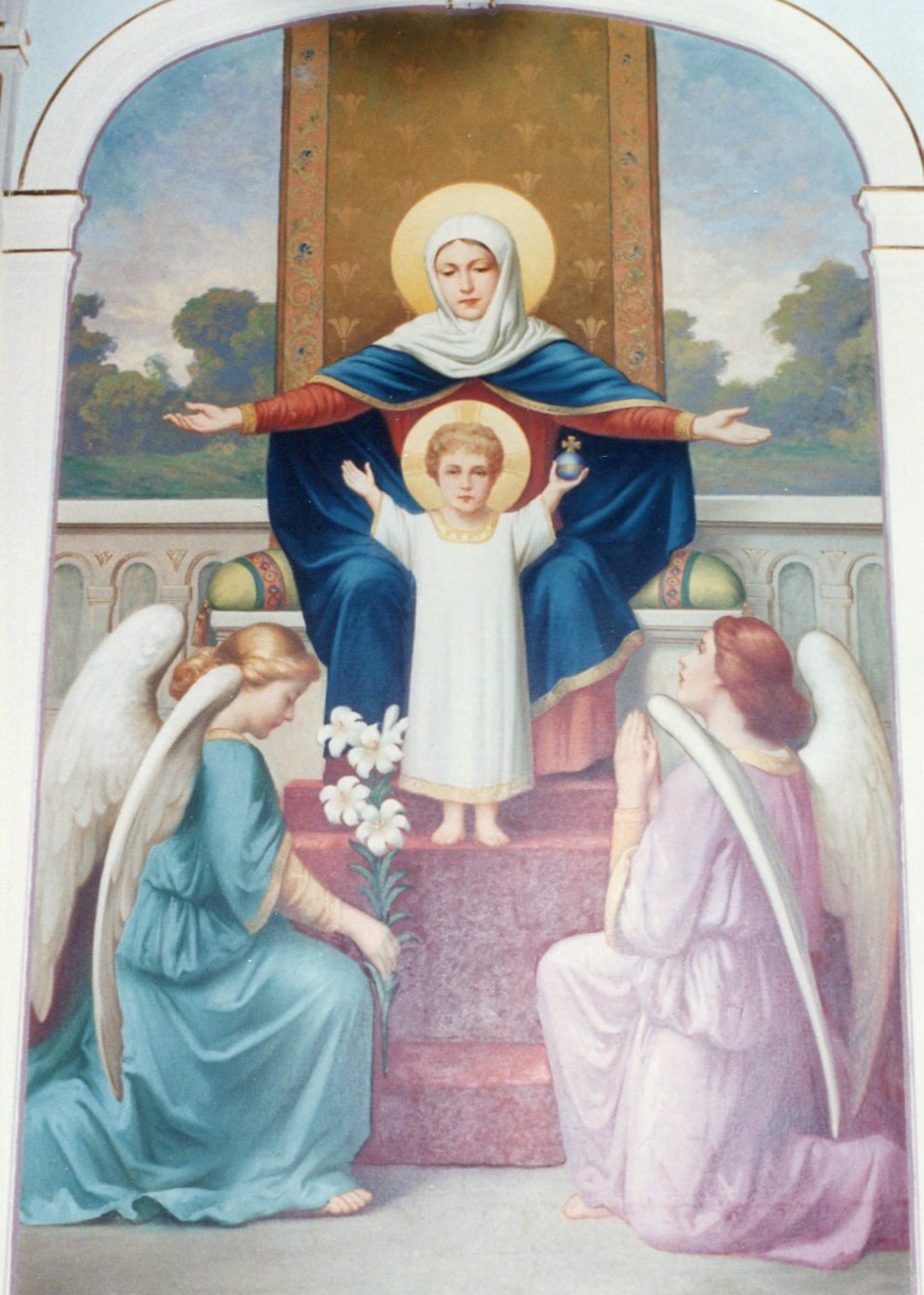 Lobby Painting (1&2/6)
Lobby Painting (1&2/6)
Sister Instructing Children: The theme of this painting was chosen to reflect our principal ministry at the time, which was teaching in parochial schools. This Benedictine tradition of teaching the young goes back to the time of St. Benedict, when Maurus and Placid who were young boys taught in the monastery. Our Sisters were lovingly committed to this ministry.
Madonna and Child: The image of Jesus as an infant has always been venerated by the Czechs. You may recall that the statue of the Infant of Prague is venerated in their city, and that accounted for miracles which happened among the Czech people. (Czech Sisters are the founders of our Monastery.) Notice that the Infant's face here is that of an adult. This was the ancient mystic way of depicting wisdom, as it was thought that wisdom comes only with age. However, we know that spiritual childhood is a necessary condition to enter heaven. “Unless you become like little children, you shall not enter the kingdom of heaven.” (Matthew 18:3.)
The six paintings in the lobby are the work of Mr. Malin (Malinovich) of Chicago, who was born in Yugoslavia. He had academic training in Church decorations.

 Lobby Painting (1&2/6)
Lobby Painting (1&2/6)
Sister Instructing Children: The theme of this painting was chosen to reflect our principal ministry at the time, which was teaching in parochial schools. This Benedictine tradition of teaching the young goes back to the time of St. Benedict, when Maurus and Placid who were young boys taught in the monastery. Our Sisters were lovingly committed to this ministry.
Madonna and Child: The image of Jesus as an infant has always been venerated by the Czechs. You may recall that the statue of the Infant of Prague is venerated in their city, and that accounted for miracles which happened among the Czech people. (Czech Sisters are the founders of our Monastery.) Notice that the Infant's face here is that of an adult. This was the ancient mystic way of depicting wisdom, as it was thought that wisdom comes only with age. However, we know that spiritual childhood is a necessary condition to enter heaven. “Unless you become like little children, you shall not enter the kingdom of heaven.” (Matthew 18:3.)
The six paintings in the lobby are the work of Mr. Malin (Malinovich) of Chicago, who was born in Yugoslavia. He had academic training in Church decorations.
Day 294: November 21, 2020
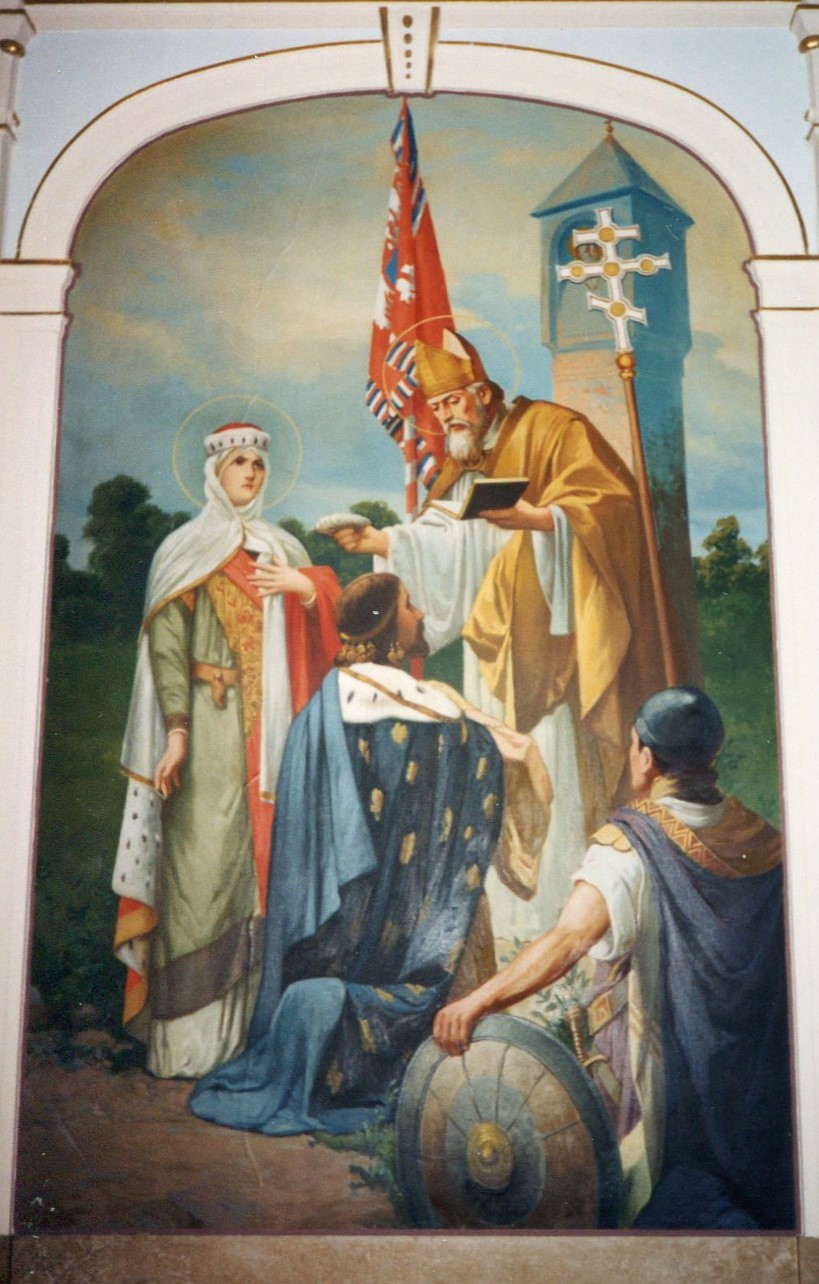
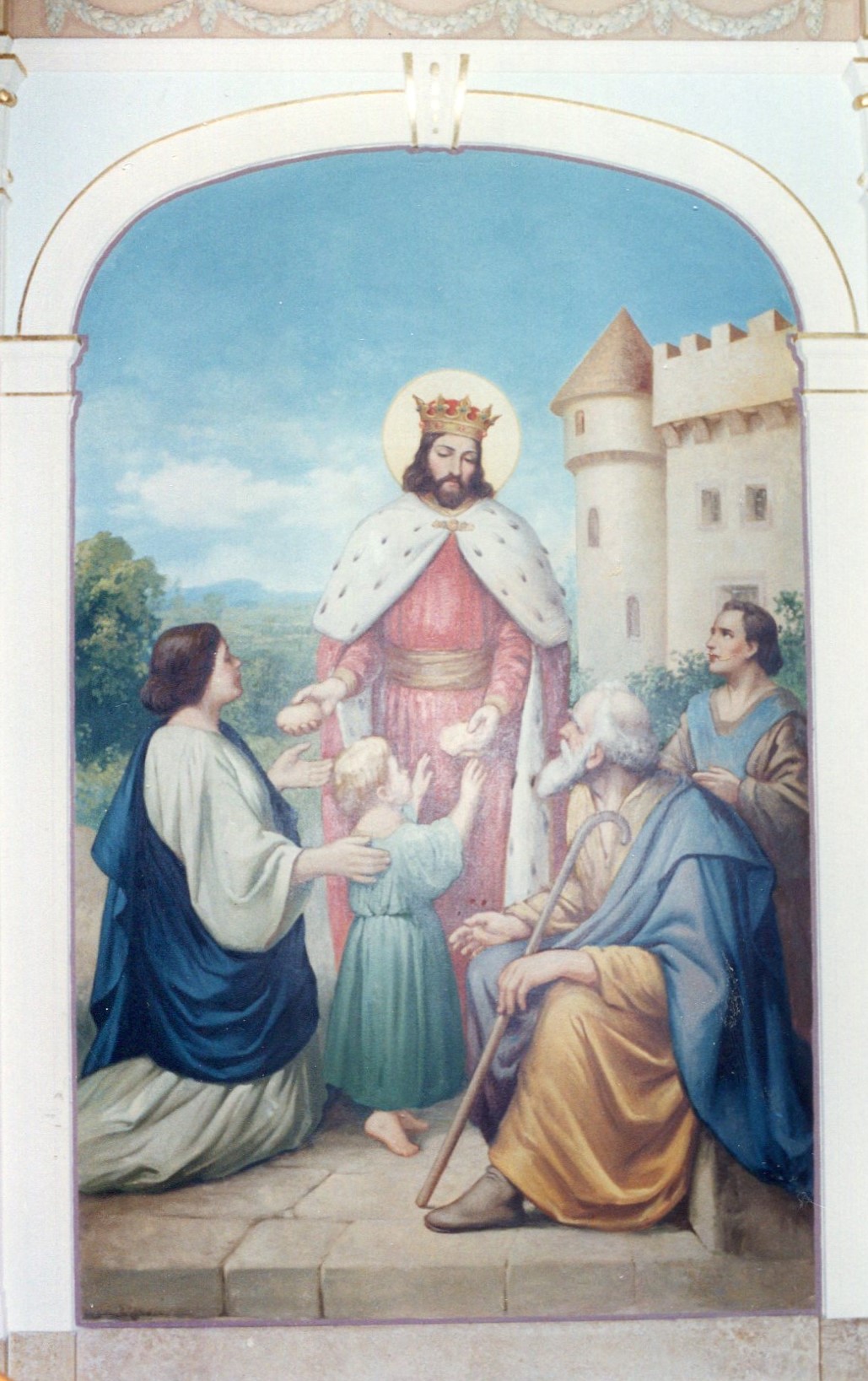 Lobby Painting (3&4/6)
Lobby Painting (3&4/6)
The Baptism of Bozhivoy: Bozhivoy, the duke of Bohemia, was the husband of St. Ludmila as well as the grandfather of St. Wenceslaus. He is pictured here being baptized by St. Methodius. Ludmila had previously embraced Christianity and is honored for her charity. She was the saintly grandmother of St. Wenceslaus, who introduced him to be a follower of Christ and to love the poor as much as she did.
St. Wenceslaus Distributing Bread to the Needy: St. Wenceslaus is the patron of Czechoslovakia. He was the grandson of St. Ludmila and Bozhivoy. In disguise and often in the dark of night, he visited the poor of his country and alleviated their poverty by distributing bread and firewood to keep families warm in the cold. In legend, he is known as the “Good King Wenceslaus” about which the inspiring classic Christmas song is written.

 Lobby Painting (3&4/6)
Lobby Painting (3&4/6)
The Baptism of Bozhivoy: Bozhivoy, the duke of Bohemia, was the husband of St. Ludmila as well as the grandfather of St. Wenceslaus. He is pictured here being baptized by St. Methodius. Ludmila had previously embraced Christianity and is honored for her charity. She was the saintly grandmother of St. Wenceslaus, who introduced him to be a follower of Christ and to love the poor as much as she did.
St. Wenceslaus Distributing Bread to the Needy: St. Wenceslaus is the patron of Czechoslovakia. He was the grandson of St. Ludmila and Bozhivoy. In disguise and often in the dark of night, he visited the poor of his country and alleviated their poverty by distributing bread and firewood to keep families warm in the cold. In legend, he is known as the “Good King Wenceslaus” about which the inspiring classic Christmas song is written.
Day 295: November 22, 2020

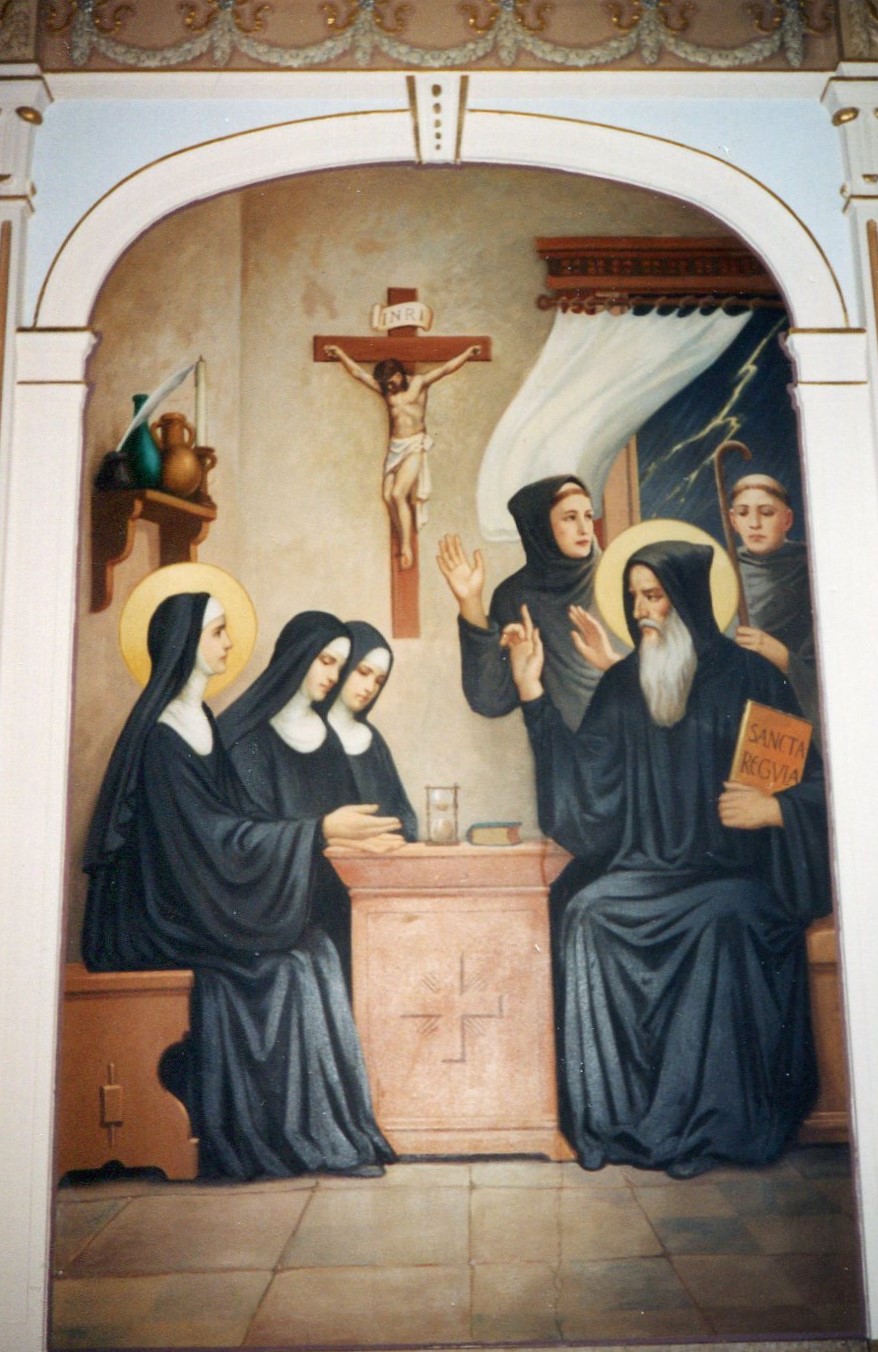 Lobby Painting (5&6/6)
Lobby Painting (5&6/6)
The Sacred Heart of Jesus: The Sacred Heart of Jesus is the patron of our community. It was our Benedictine St. Gertrude the Great who had visions of the Sacred Heart of Jesus and started this devotion. When our founding Sisters deliberated about a name for our monastery, they decided they wanted the devotion to the Sacred Heart of Jesus to continue through the ages. The name of the Sacred Heart of Jesus for our monastery would be a constant reminder to everyone of God’s sacred presence. What a blessing it is to hallow the name of Jesus in saying the name of Sacred Heart Monastery.
The Last Meeting of St. Scholastica and St. Benedict: Benedict’s sister, Scholastica, was consecrated to God from early childhood and Benedict would visit with her once a year with a few of his disciples. They would spend the whole day singing God’s praises and conversing about the spiritual life. When darkness came, Scholastica asked her brother to stay till morning. The sky was clear; there was not a cloud in sight. However, Benedict refused to stay. So Scholastica put her head on the table praying earnestly. When she looked up, a sudden burst of thunder and lightning with a strong downpour prevented Benedict to set foot out the door. He and his disciples had to stay all night. It was a privileged time talking about the joys of heaven. Scholastica died three days later.
This meeting of Scholastica’s miracle is recorded in the dialogues of St. Gregory who was a Benedictine monk.

 Lobby Painting (5&6/6)
Lobby Painting (5&6/6)
The Sacred Heart of Jesus: The Sacred Heart of Jesus is the patron of our community. It was our Benedictine St. Gertrude the Great who had visions of the Sacred Heart of Jesus and started this devotion. When our founding Sisters deliberated about a name for our monastery, they decided they wanted the devotion to the Sacred Heart of Jesus to continue through the ages. The name of the Sacred Heart of Jesus for our monastery would be a constant reminder to everyone of God’s sacred presence. What a blessing it is to hallow the name of Jesus in saying the name of Sacred Heart Monastery.
The Last Meeting of St. Scholastica and St. Benedict: Benedict’s sister, Scholastica, was consecrated to God from early childhood and Benedict would visit with her once a year with a few of his disciples. They would spend the whole day singing God’s praises and conversing about the spiritual life. When darkness came, Scholastica asked her brother to stay till morning. The sky was clear; there was not a cloud in sight. However, Benedict refused to stay. So Scholastica put her head on the table praying earnestly. When she looked up, a sudden burst of thunder and lightning with a strong downpour prevented Benedict to set foot out the door. He and his disciples had to stay all night. It was a privileged time talking about the joys of heaven. Scholastica died three days later.
This meeting of Scholastica’s miracle is recorded in the dialogues of St. Gregory who was a Benedictine monk.
Day 296: November 23, 2020
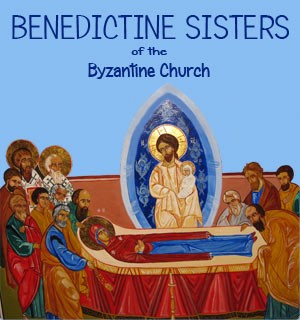
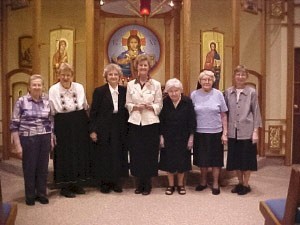 Eastern Rite Icon and Our Eastern Rite Sisters
Eastern Rite Icon and Our Eastern Rite Sisters
Note the deep respect shown by the apostles in this icon, Mary is venerated as the “Theotokos” or Christ bearer. She is seen here in a dormition (sleep) state before her body was taken up to heaven. This icon was a precious gift to our Benedictine Sisters when they came to Warren, Ohio. The artist was Brother Nicholas from Butler, PA.
The Eastern Rite Catholic Church, which includes the Byzantine Rite, is in full communion with the Pope in Rome. However starting with St. Peter, the first Pope in Rome, Latin became the spoken language in the West for those who followed the Roman Rite in its Liturgy. Whereas, the language of the East, as well as its culture, was that of the people who lived in various parts of the East. Thus, their worship, called the Divine Liturgy, and their Eucharistic celebration is different from our Roman Rite in its cultural format and theological emphasis, but is equally the Eucharistic Celebration.
In 1954, our Benedictine Sisters were asked to staff St. Peter and Paul School, which was of the Byzantine Rite in Warren, Ohio. Our Byzantine Rite Sisters belong to this Rite, and when celebrating their Divine Liturgy, they follow the Byzantine Rite format and prayer structure. They feature icons instead of statues.
The photo on the right was taken in their chapel in Queen of Heaven Monastery in 2008 and shows our Sisters (L-R) Sisters Barbara Pavlik, Mary Martha Kacmarek, Margaret Mary Schima, (former prioress) Marion Dobos, Julie Rohaly, Mary John Semon, and Agnes Knapik.
 Eastern Rite Icon and Our Eastern Rite Sisters
Eastern Rite Icon and Our Eastern Rite Sisters
Note the deep respect shown by the apostles in this icon, Mary is venerated as the “Theotokos” or Christ bearer. She is seen here in a dormition (sleep) state before her body was taken up to heaven. This icon was a precious gift to our Benedictine Sisters when they came to Warren, Ohio. The artist was Brother Nicholas from Butler, PA.
The Eastern Rite Catholic Church, which includes the Byzantine Rite, is in full communion with the Pope in Rome. However starting with St. Peter, the first Pope in Rome, Latin became the spoken language in the West for those who followed the Roman Rite in its Liturgy. Whereas, the language of the East, as well as its culture, was that of the people who lived in various parts of the East. Thus, their worship, called the Divine Liturgy, and their Eucharistic celebration is different from our Roman Rite in its cultural format and theological emphasis, but is equally the Eucharistic Celebration.
In 1954, our Benedictine Sisters were asked to staff St. Peter and Paul School, which was of the Byzantine Rite in Warren, Ohio. Our Byzantine Rite Sisters belong to this Rite, and when celebrating their Divine Liturgy, they follow the Byzantine Rite format and prayer structure. They feature icons instead of statues.
The photo on the right was taken in their chapel in Queen of Heaven Monastery in 2008 and shows our Sisters (L-R) Sisters Barbara Pavlik, Mary Martha Kacmarek, Margaret Mary Schima, (former prioress) Marion Dobos, Julie Rohaly, Mary John Semon, and Agnes Knapik.
Day 297: November 24, 2020
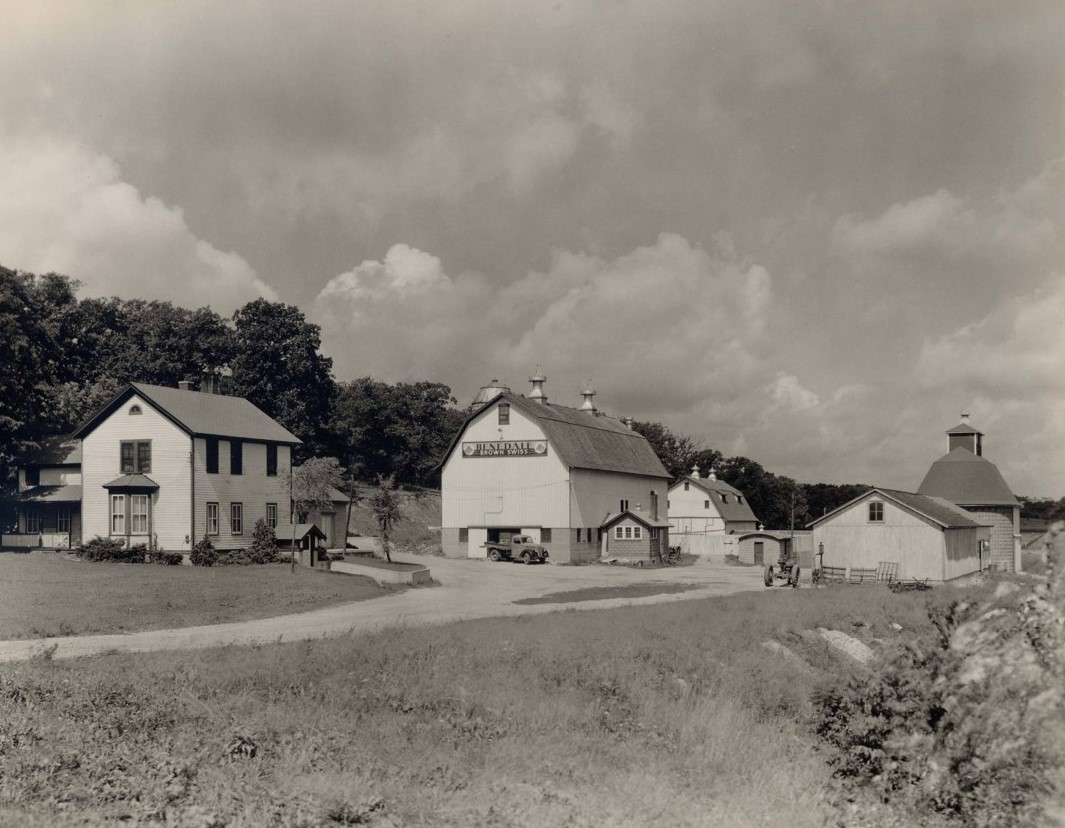 History of Our Benedale Farm
History of Our Benedale Farm
St Benedict (c.480-547) lived in sixth century Italy, when the great Roman Empire had fallen to the Barbarian tribes who invaded Italy. By the influence of his Rule for monastic life, Benedict created a fundamental change in the development of European civilization and culture, which helped Europe to emerge from the dark night of the fall of the Roman Empire. Benedict established new monasteries throughout Europe whereupon the monks began to restore the land around them to productivity, basic in feeding hungry people after the Roman Empires’ collapse. Benedict’s principle of work was an important point in our Benedictine history and was the reason for our Benedale Farm. The Benedictines were in Lisle to value the earth, to plant, and to harvest. Our Sisters raised chickens and turkeys with so much care producing eggs and meat, and our gardens and orchards provided our fruits and vegetables. Our hired men cultivated 321 tillable acres of land raising corn, oats, wheat, and hay to feed the cattle and pigs which provided the milk and meat for the Sisters in the monastery and the girls in the Academy. From 1936, the Benedale Farm with its prize cattle and pigs was managed by Mr. Rambousek with a few hired men. However in 1963, our land, except for our 47 acres, was sold to be developed for the park district, housing, and community services or businesses in Lisle.
 History of Our Benedale Farm
History of Our Benedale Farm
St Benedict (c.480-547) lived in sixth century Italy, when the great Roman Empire had fallen to the Barbarian tribes who invaded Italy. By the influence of his Rule for monastic life, Benedict created a fundamental change in the development of European civilization and culture, which helped Europe to emerge from the dark night of the fall of the Roman Empire. Benedict established new monasteries throughout Europe whereupon the monks began to restore the land around them to productivity, basic in feeding hungry people after the Roman Empires’ collapse. Benedict’s principle of work was an important point in our Benedictine history and was the reason for our Benedale Farm. The Benedictines were in Lisle to value the earth, to plant, and to harvest. Our Sisters raised chickens and turkeys with so much care producing eggs and meat, and our gardens and orchards provided our fruits and vegetables. Our hired men cultivated 321 tillable acres of land raising corn, oats, wheat, and hay to feed the cattle and pigs which provided the milk and meat for the Sisters in the monastery and the girls in the Academy. From 1936, the Benedale Farm with its prize cattle and pigs was managed by Mr. Rambousek with a few hired men. However in 1963, our land, except for our 47 acres, was sold to be developed for the park district, housing, and community services or businesses in Lisle.
Day 298: November 25, 2020
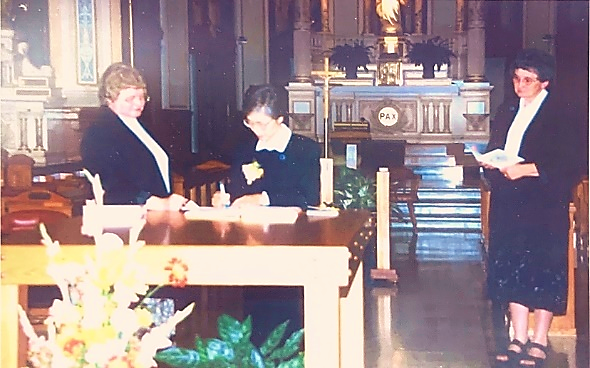 Sister Johanna’s Profession-October 15, 2002
Sister Johanna’s Profession-October 15, 2002
In this photo, our Sister Johanna Soomi Choi, OSB, is signing her perpetual vow formula during a public ceremony. Sister Judith Ann Heble, former prioress, is on her left and Sister Joan Marie Soukop, former formation director, is on her right. Sister Johanna Choi is a native of South Korea, who lived during the horrors of the Korean War and is now very happy to be a citizen of the United States. She is grateful to be a Benedictine Sister here at Sacred Heart Monastery. She has contributed so much to our Liturgical music by understanding how to adjust the notes to our singing ability, organizing the music files in the Liturgy Office, providing us with our daily chant copies, as well as being the main cantor using her lovely singing voice to enhance our community chant.
 Sister Johanna’s Profession-October 15, 2002
Sister Johanna’s Profession-October 15, 2002
In this photo, our Sister Johanna Soomi Choi, OSB, is signing her perpetual vow formula during a public ceremony. Sister Judith Ann Heble, former prioress, is on her left and Sister Joan Marie Soukop, former formation director, is on her right. Sister Johanna Choi is a native of South Korea, who lived during the horrors of the Korean War and is now very happy to be a citizen of the United States. She is grateful to be a Benedictine Sister here at Sacred Heart Monastery. She has contributed so much to our Liturgical music by understanding how to adjust the notes to our singing ability, organizing the music files in the Liturgy Office, providing us with our daily chant copies, as well as being the main cantor using her lovely singing voice to enhance our community chant.
Day 299: November 26, 2020
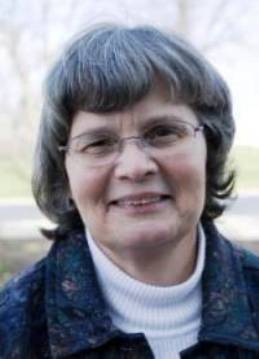 Stola, Sister Sharon Marie b. 11/26
Stola, Sister Sharon Marie b. 11/26
Sister Sharon Marie has been commissioned for several years now to work in the Diocese of Joliet as the head of the Office of Divine Worship and the Catechumenate. Among her many duties in this position, she is responsible to plan diocesan ceremonies and incorporate every culture and nationality represented in the diocese for active participation. Besides this commitment, she is assisting in a diocesan parish, being in charge of the liturgy there as well. In Community, she is the sub-prioress and is active on the monastic council. In juggling her leadership responsibilities, she maintains a tireless effort to manage each location with proficiency.
 Stola, Sister Sharon Marie b. 11/26
Stola, Sister Sharon Marie b. 11/26
Sister Sharon Marie has been commissioned for several years now to work in the Diocese of Joliet as the head of the Office of Divine Worship and the Catechumenate. Among her many duties in this position, she is responsible to plan diocesan ceremonies and incorporate every culture and nationality represented in the diocese for active participation. Besides this commitment, she is assisting in a diocesan parish, being in charge of the liturgy there as well. In Community, she is the sub-prioress and is active on the monastic council. In juggling her leadership responsibilities, she maintains a tireless effort to manage each location with proficiency.
Day 300: November 27, 2020
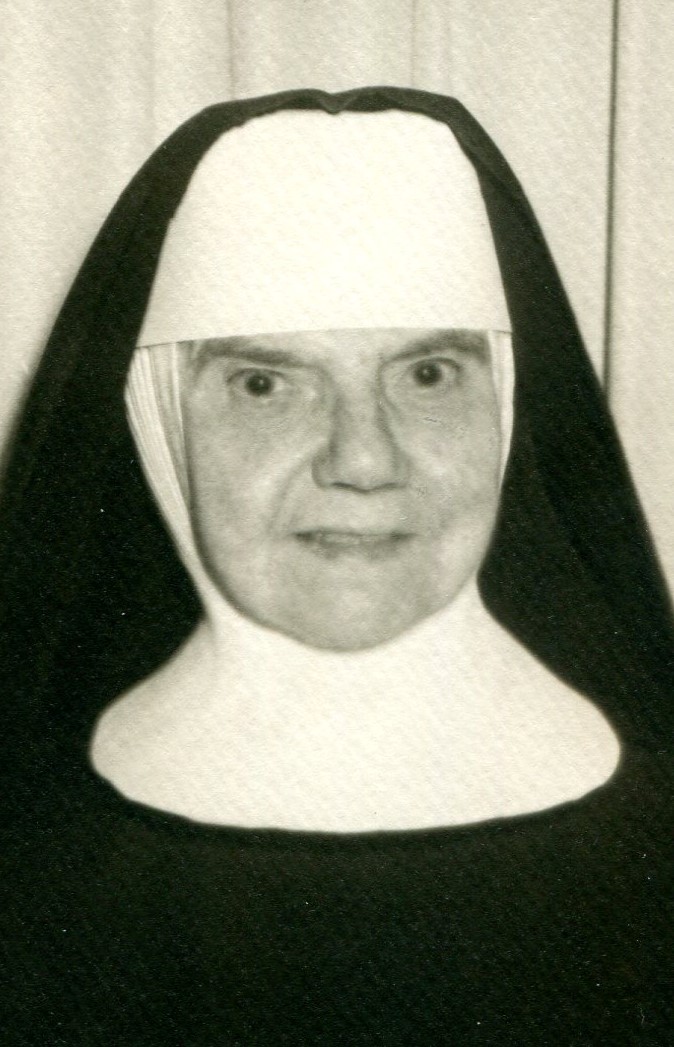 Vavrunek, Sister Mary Rose b. 1/21/1884 d. 11/27/1969
Vavrunek, Sister Mary Rose b. 1/21/1884 d. 11/27/1969
Sister Mary Rose, known always as a grateful Sister, died on Thanksgiving Day in 1969. The day was appropriate as she was a model of saying “thank you” or spreading encouragement to those who found life difficult. To know her or to interact with her was to become a better person, for her confidence in you was so admirable. Like so many of our pioneer Sisters, she was never discouraged with the poverty or the seemingly hopeless future, as she trusted that God was present and would always make things right. Her hope in the future was eternal life and that was something beyond anyone’s imagination worth striving for.
 Vavrunek, Sister Mary Rose b. 1/21/1884 d. 11/27/1969
Vavrunek, Sister Mary Rose b. 1/21/1884 d. 11/27/1969
Sister Mary Rose, known always as a grateful Sister, died on Thanksgiving Day in 1969. The day was appropriate as she was a model of saying “thank you” or spreading encouragement to those who found life difficult. To know her or to interact with her was to become a better person, for her confidence in you was so admirable. Like so many of our pioneer Sisters, she was never discouraged with the poverty or the seemingly hopeless future, as she trusted that God was present and would always make things right. Her hope in the future was eternal life and that was something beyond anyone’s imagination worth striving for.
Day 301: November 28, 2020
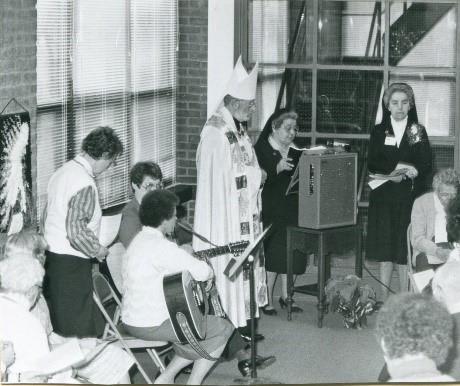 Blessing of Queen of Peace Retirement Center
Blessing of Queen of Peace Retirement Center
In the Benedictine Sisters’ history in 1977, the Sisters moved into the renovated Academy building leaving the former monastery building vacant. After much discernment and prayer as how best to use that vacant building to serve the community of people around us, it was decided to use it as a retirement center and it was given the name: Queen of Peace Retirement Center. It opened in 1987, and the 32 units were made available for retired friends and an efficient staff with whom the Sisters developed close relationships. The photo has Abbot Hugh Anderson blessing this residency. Sister Regina Dubina was the Prioress, and Sister Agnes Ann Svec was its first administrator, followed by Sister Benita Jasurda and Sister Karen Nykiel.
By 1997, a task force study of Queen of Peace was begun to make long-range strategic plans for expansion and to look for co-sponsorship possibilities. (Continued on November 30th)
 Blessing of Queen of Peace Retirement Center
Blessing of Queen of Peace Retirement Center
In the Benedictine Sisters’ history in 1977, the Sisters moved into the renovated Academy building leaving the former monastery building vacant. After much discernment and prayer as how best to use that vacant building to serve the community of people around us, it was decided to use it as a retirement center and it was given the name: Queen of Peace Retirement Center. It opened in 1987, and the 32 units were made available for retired friends and an efficient staff with whom the Sisters developed close relationships. The photo has Abbot Hugh Anderson blessing this residency. Sister Regina Dubina was the Prioress, and Sister Agnes Ann Svec was its first administrator, followed by Sister Benita Jasurda and Sister Karen Nykiel.
By 1997, a task force study of Queen of Peace was begun to make long-range strategic plans for expansion and to look for co-sponsorship possibilities. (Continued on November 30th)
Day 302: November 29, 2020
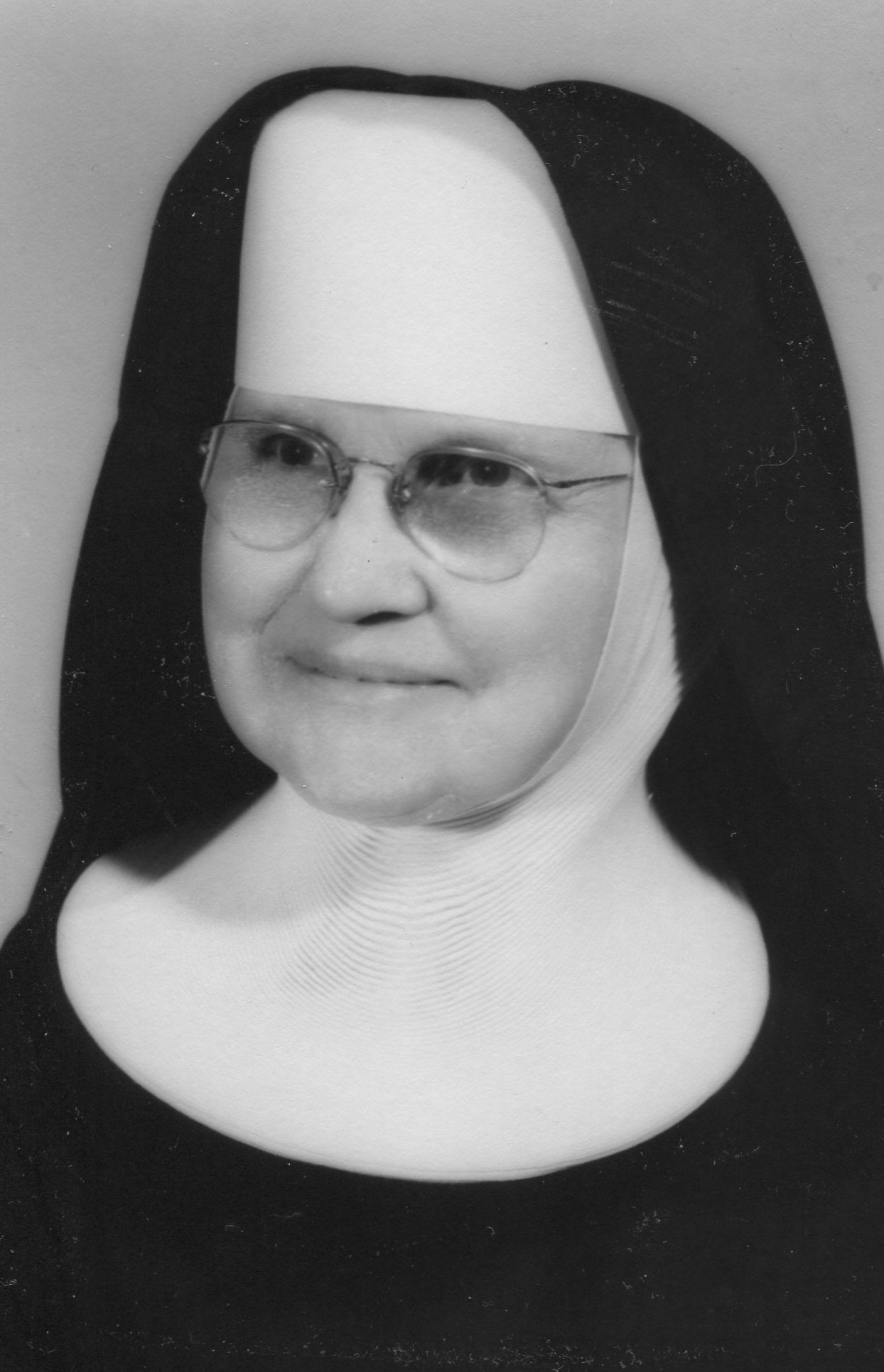 Brisko, Sister Mary Borgia b. 9/13/1887 d. 11/29/1965
Brisko, Sister Mary Borgia b. 9/13/1887 d. 11/29/1965
Sister Mary Borgia was well known for giving violin and piano lessons to her protégé, Sister Mary Gilbert. Truly, Sister Mary Borgia was a talented music teacher like her Prague, Czechoslovakian, ancestral musicians. Besides giving music lessons, she had many duties in the Academy. Overseeing the dining rooms was one of them as well as being the Sister who would roll out the food wagon at 3 o’clock p.m. with fresh bakery for the girls’ snack after classes. With a twinkle in her eye, she stood and watched the girls devour the bakery. She knew that the girls were hungry, and she enjoyed seeing the camaraderie and the conversation of excitement.
 Brisko, Sister Mary Borgia b. 9/13/1887 d. 11/29/1965
Brisko, Sister Mary Borgia b. 9/13/1887 d. 11/29/1965
Sister Mary Borgia was well known for giving violin and piano lessons to her protégé, Sister Mary Gilbert. Truly, Sister Mary Borgia was a talented music teacher like her Prague, Czechoslovakian, ancestral musicians. Besides giving music lessons, she had many duties in the Academy. Overseeing the dining rooms was one of them as well as being the Sister who would roll out the food wagon at 3 o’clock p.m. with fresh bakery for the girls’ snack after classes. With a twinkle in her eye, she stood and watched the girls devour the bakery. She knew that the girls were hungry, and she enjoyed seeing the camaraderie and the conversation of excitement.
Day 303: November 30, 2020
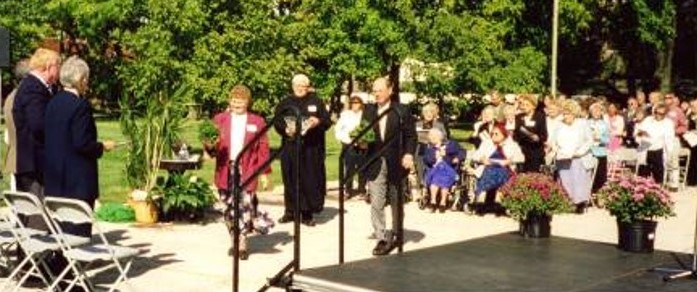 Ground-Breaking for Villa St Benedict-June 27, 2003
Ground-Breaking for Villa St Benedict-June 27, 2003
By 2000, it was agreed to change the name of Queen of Peace to Villa St. Benedict, and a co-sponsorship agreement was finalized with Benedictine Health System (now called Benedictine) in Duluth, MN. Glenn Trembley became the CEO and the preparation and challenges included marketing, financing, professional assistance, and of course, the prayer of the Sisters.
In this photo we see Sister Judith Ann Heble, OSB, the prioress at that time, leading the groundbreaking events with Glenn Trembley, CEO, and Father Becket Franks, OSB, as chaplain. This was the day our dream of furthering our ministry of hospitality began to unfold where many people gathered, the sky was blue, the temperature was perfect, the trees and grass were green, and the flowers were in bloom. As Mr. Trembley concluded his opening remarks, he gave directions for shovels to be distributed and bulldozers to be ready. Then, giving the signal, the participants began to dig, and the bulldozers began to blare. There was excitement in the air; it was a day to sound off and sing, “Holy God We Praise Thy Name.” A picnic lunch concluded this memorable, promising event.
In this photo we see Sister Judith Ann Heble, OSB, the prioress at that time, leading the groundbreaking events with Glenn Trembley, CEO, and Father Becket Franks, OSB, as chaplain. This was the day our dream of furthering our ministry of hospitality began to unfold where many people gathered, the sky was blue, the temperature was perfect, the trees and grass were green, and the flowers were in bloom. As Mr. Trembley concluded his opening remarks, he gave directions for shovels to be distributed and bulldozers to be ready. Then, giving the signal, the participants began to dig, and the bulldozers began to blare. There was excitement in the air; it was a day to sound off and sing, “Holy God We Praise Thy Name.” A picnic lunch concluded this memorable, promising event.
 Ground-Breaking for Villa St Benedict-June 27, 2003
Ground-Breaking for Villa St Benedict-June 27, 2003
By 2000, it was agreed to change the name of Queen of Peace to Villa St. Benedict, and a co-sponsorship agreement was finalized with Benedictine Health System (now called Benedictine) in Duluth, MN. Glenn Trembley became the CEO and the preparation and challenges included marketing, financing, professional assistance, and of course, the prayer of the Sisters.
In this photo we see Sister Judith Ann Heble, OSB, the prioress at that time, leading the groundbreaking events with Glenn Trembley, CEO, and Father Becket Franks, OSB, as chaplain. This was the day our dream of furthering our ministry of hospitality began to unfold where many people gathered, the sky was blue, the temperature was perfect, the trees and grass were green, and the flowers were in bloom. As Mr. Trembley concluded his opening remarks, he gave directions for shovels to be distributed and bulldozers to be ready. Then, giving the signal, the participants began to dig, and the bulldozers began to blare. There was excitement in the air; it was a day to sound off and sing, “Holy God We Praise Thy Name.” A picnic lunch concluded this memorable, promising event.
In this photo we see Sister Judith Ann Heble, OSB, the prioress at that time, leading the groundbreaking events with Glenn Trembley, CEO, and Father Becket Franks, OSB, as chaplain. This was the day our dream of furthering our ministry of hospitality began to unfold where many people gathered, the sky was blue, the temperature was perfect, the trees and grass were green, and the flowers were in bloom. As Mr. Trembley concluded his opening remarks, he gave directions for shovels to be distributed and bulldozers to be ready. Then, giving the signal, the participants began to dig, and the bulldozers began to blare. There was excitement in the air; it was a day to sound off and sing, “Holy God We Praise Thy Name.” A picnic lunch concluded this memorable, promising event.
Back to the Top, Back to the Celebrating 125 Years Page or Back to Home Page
